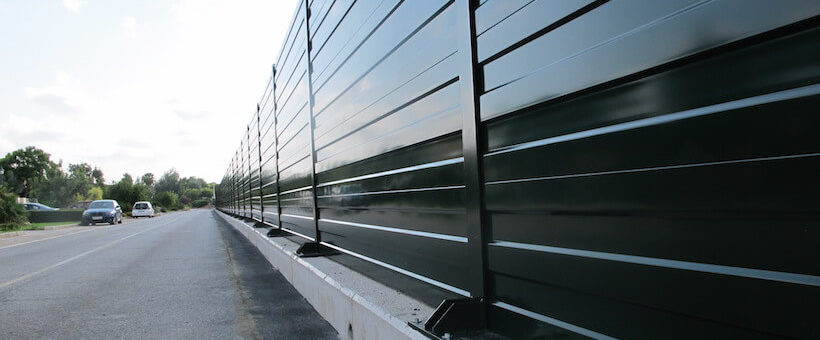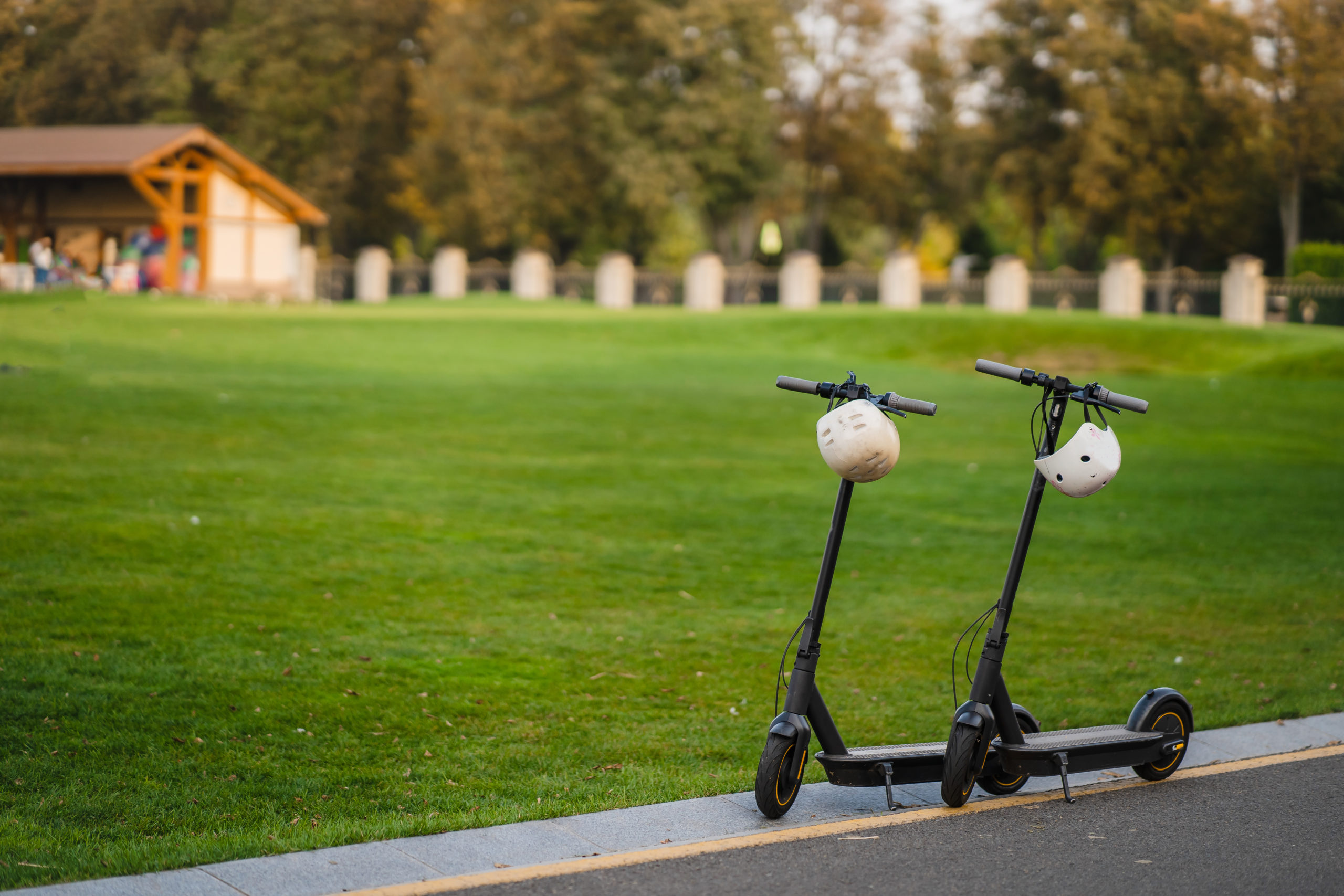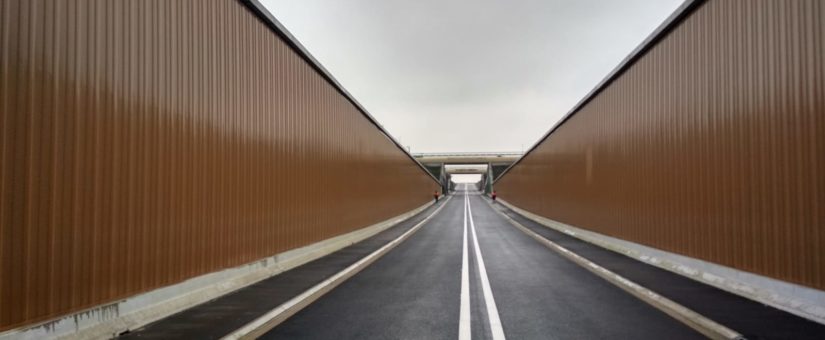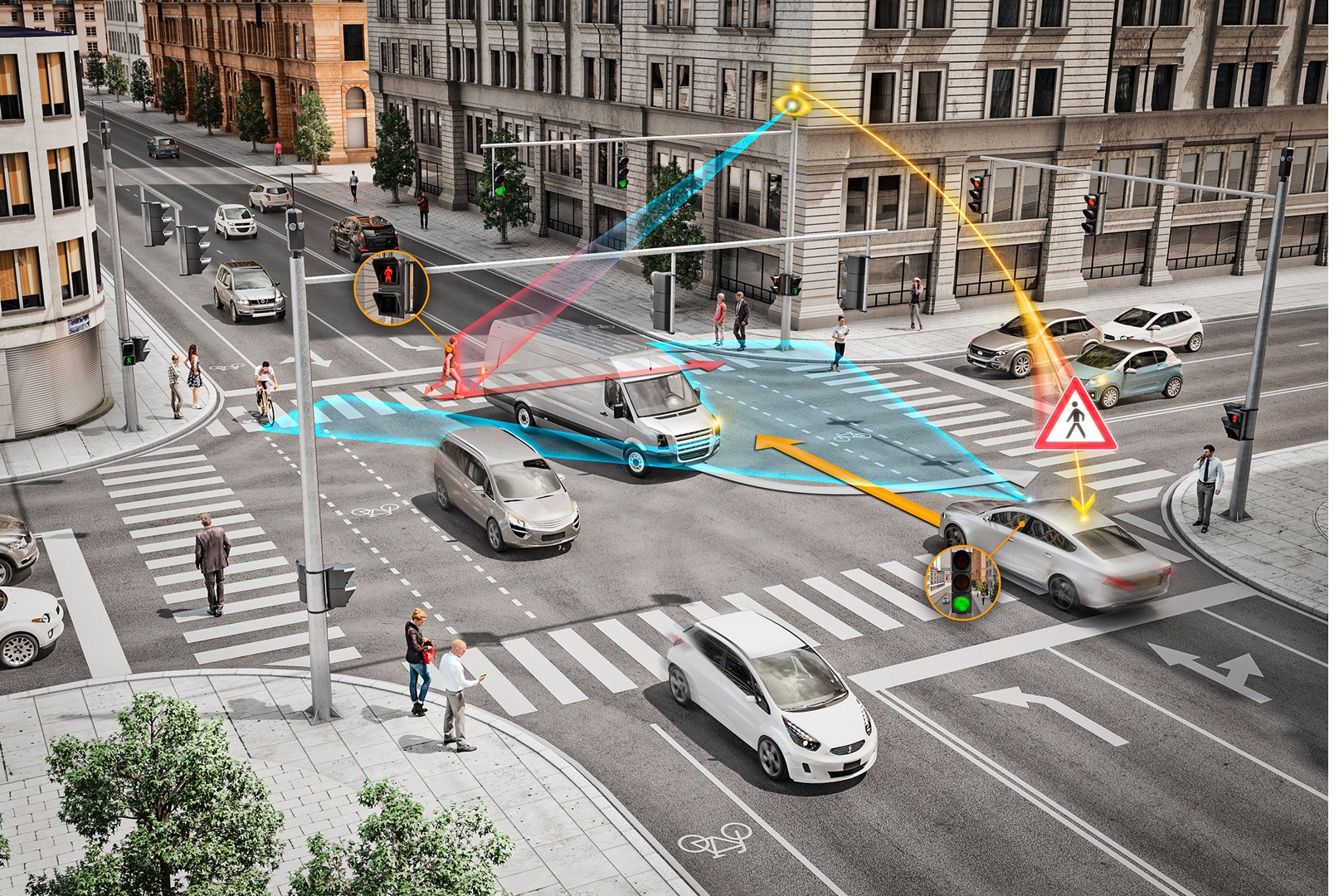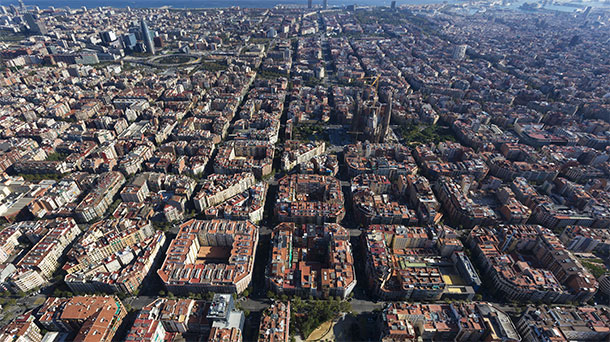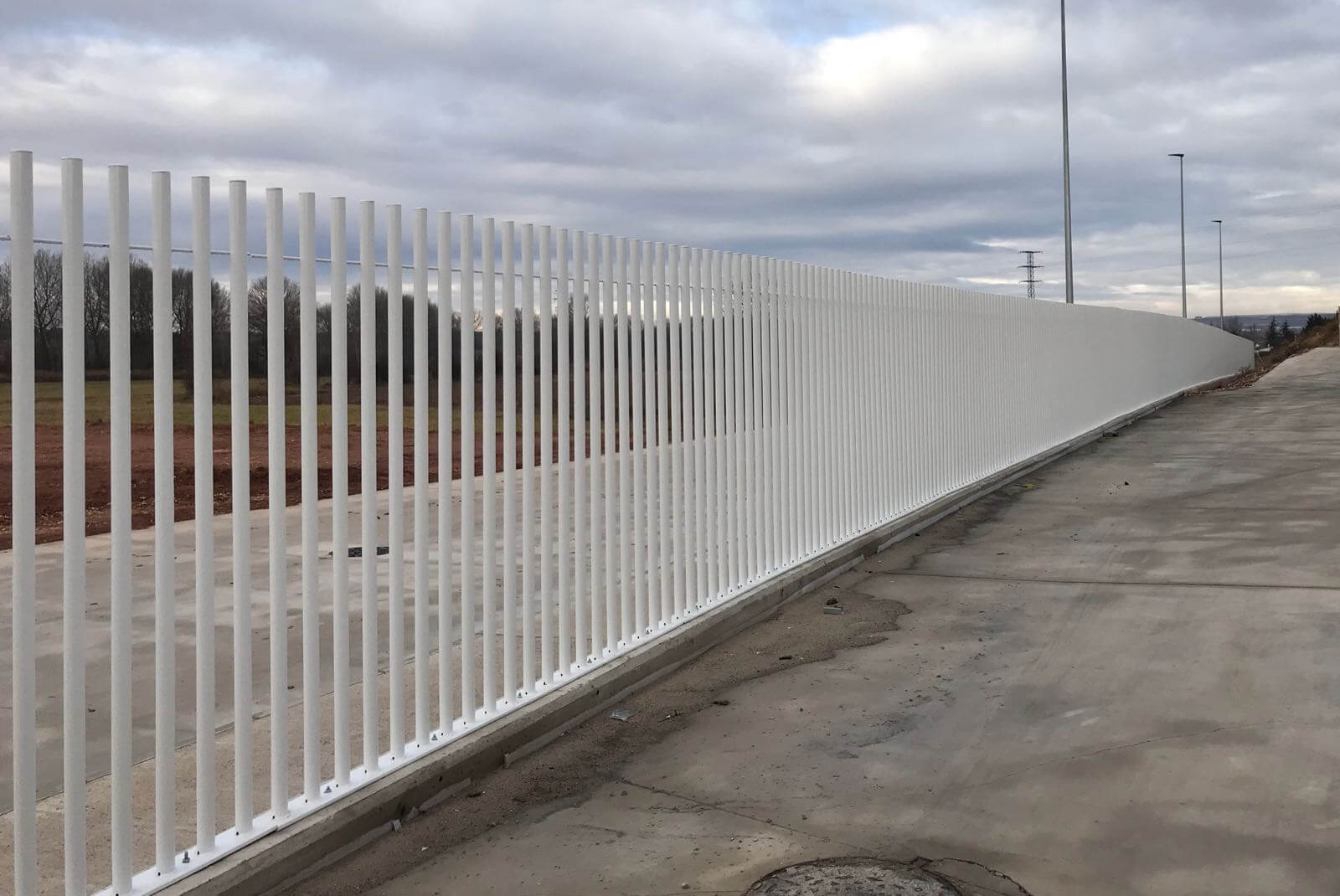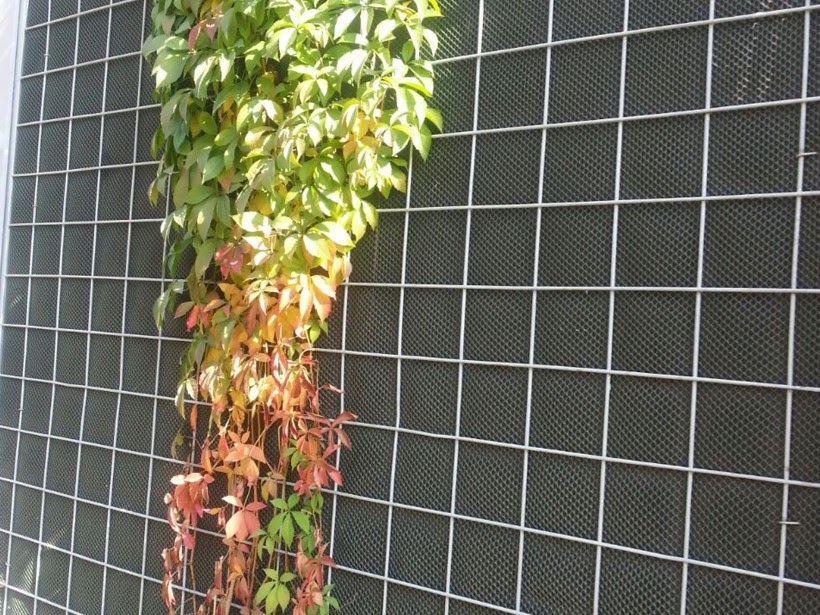The loudest roads and railway areas of the Valencian Community
It is no secret that both roads and railways are sources of excessive noise, causing annoyance both to the population and to the conservation of the environment. Specifically in the Valencian Community, it is estimated that approximately 183,000 inhabitants are daily exposed to noise that comes from the main infrastructures, which is a quite alarming fact considering the negative consequences of noise pollution.
The CV-35, one of the roads with the highest levels of noise pollution
The acoustic studies carried out in the main roads of the Valencian Community have concluded that the CV-35 is one of the most affected road, since around 10,000 people support up to 75 decibels at peak times of the day.
Another section with a high noise concentration is the one between Vilamarxant and Benisanó on the CV-50. In this area there are several schools and institutes that must withstand noises of up to 70 decibels.
On the other hand, although the railway network generates less acoustic nuisance, we must also focus on the acoustic problems that derive from the noise of the trains.
According to a European Environment Agency (EEA) report in 2010, railway noise affected over 12 million inhabitants of the European Union every day, figures that may well have increased since that time.
Rail noise in Europe is especially concentrated in Western European countries, among which is Spain. The main sources of noise pollution in railways are engine, rolling and aerodynamic noise, while the most annoying ones are produced by freight trains. We must not forget that passenger stations, places for receiving goods (dry ports), train maintenance activities and other facilities also generate noise in their daily operation. Given this, it may seem that noise pollution caused by the railway and its facilities is almost impossible to eliminate, but the truth is that it is easier to mitigate.

Consequences of noise pollution for our health
As we have seen, there are high figures that confirm that many people are victims of the problems derived by noise pollution from roads and railway areas in the Valencian Community. What are the harmful consequences of excess noise for health?
- Hearing problems: it is the most common and one of the most worrisome. Keep in mind that any sound above 85 decibels can damage hearing, and on roads and railways, this limit is often far exceeded. Someone who lives in this type of area is continuously exposed to a very high noise level, and consequently can develop hearing loss.
- Cardiovascular problems: Constant exposure to high noise levels can increase blood pressure, increase heart rate and increase stress by releasing the hormone cortisol ... All of this can lead to an imbalance of vital body functions.
- Sleep problems: If the home is near highway areas, the noise from freight trucks is very likely to cause sleep disturbances. As we mentioned in the previous point, cardiovascular problems are a long-term effect of this exposure to excess noise. In the short term, the most notable are fatigue, impaired memory and creative abilities, and difficulty concentrating.
- Digestive problems: Although to a lesser extent, there are studies that have shown that excess noise leads to a decrease in peristalsis, that is, muscle contractions thanks to which the food eaten moves through the digestive system. As a consequence, problems such as gastritis, ulcers, heartburn, loss of appetite, diarrhea or constipation may be more frequent.
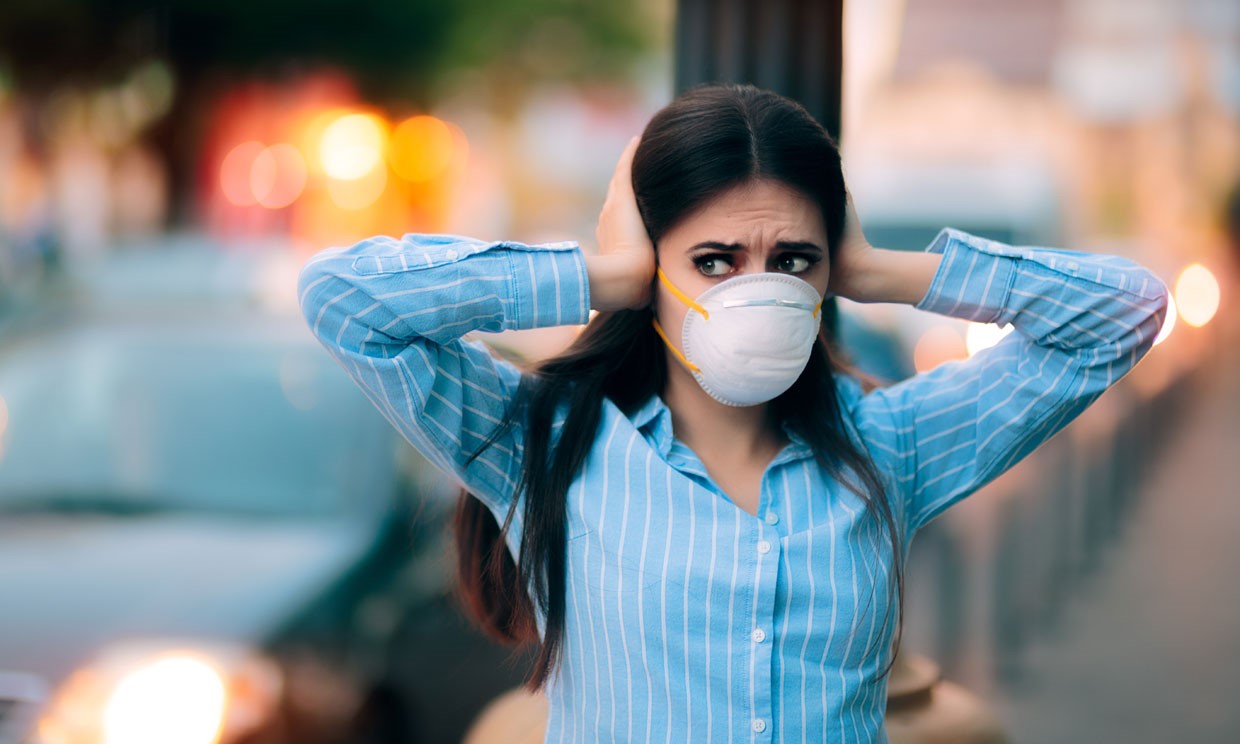
How can we solve this problem?
The expansion of urban centers towards industrial areas has meant that many living areas are located very close to road and railway infrastructures, and this requires effective solutions that eliminate excess of noise.
Acoustic Screens
As experts in acoustic solutions, from Metalesa we can certify that acoustic screens are an effective solution to reduce or eliminate this noise. But first, from Metalesa we get in charge of conducting acoustic studies, which are used to extract noise maps that measure noise pollution in a specific area, and based on the results, we take care of adopting the necessary measures through the installation of acoustic screens.
Types of acoustic screens for roads and railway areas
Steel or aluminium metal acoustic screen
These types of acoustic screens are made up of galvanized steel or aluminum panels, which are vertically superimposed between HEA / HEB profiles until the desired height is achieved. By installing metal acoustic screens on roads or railway areas close to human environments, we obtain maximum insulation and absorption, which is a very effective solution to counteract the negative effects of noise.
In addition, other advantages of the metallic acoustic screen are its ease of installation, its long durability thanks to the quality of its components, and its resistance to loads such as the action of the wind or the overpressures produced by rail traffic.
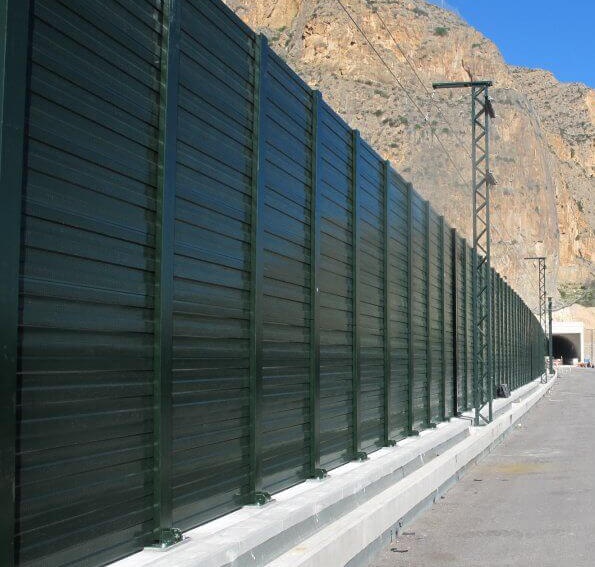
Metallic acoustic screen with mesh or vegetable
This type of plant acoustic noise screens also achieve great noise absorption and acoustic insulation in road and railway areas. Inside the panels that form it, rock wool is placed together with a green plastic mesh that facilitates the growth of vegetation.
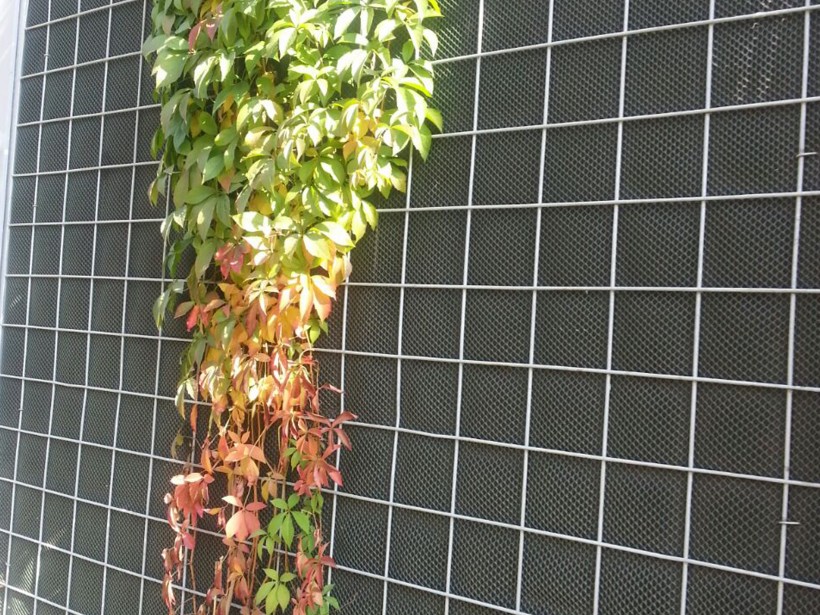
Methacrylate acoustic screen
Las características acústicas de las pantallas acústicas de metacrilato o vidrio también son muy eficientes. Están formadas por paneles de metacrilato cuyas propiedades de aislamiento han sido evaluadas de acuerdo a la norma EN 1793-2:1998, obteniendo un elevado índice de aislamiento.
The acoustic characteristics of methacrylate or glass acoustic screens are also very efficient. They are made of methacrylate panels whose insulation properties have been evaluated according to the EN 1793-2: 1998 standard, obtaining a high insulation index.
In addition, it is an easy-to-install acoustic screen, which allows landscape integration, and has a long durability thanks to the quality of its components. For all this, they are ideal to be installed in noisy areas.
Methacrylate can be transparent or have a certain color. Likewise, it is possible to install vinyl solutions on the methacrylate to prevent damage to the birds in the environment.
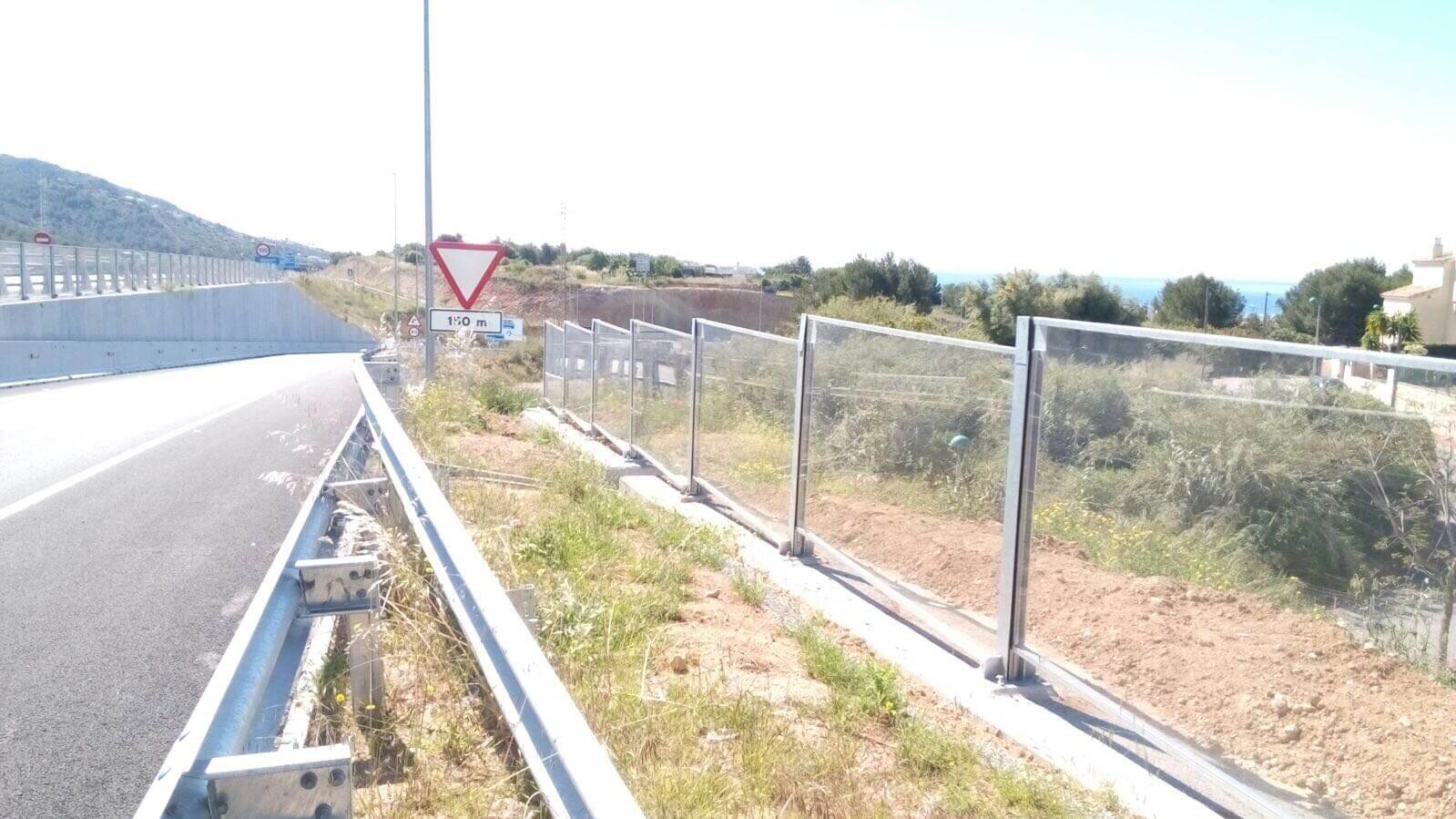
Wooden Acoustic Screen
This wooden anti-noise screen performs a double acoustic and aesthetic function and is made up of the following elements:
- Absorbent and reflective face: treated Scots pine wood slats.
- Acoustic insulation: rock wool with black protective veil.
- Supporting structure: made up of HEA / HEB-type uprights with hot-dip galvanized welded base plate and painted with polyester powder paint.
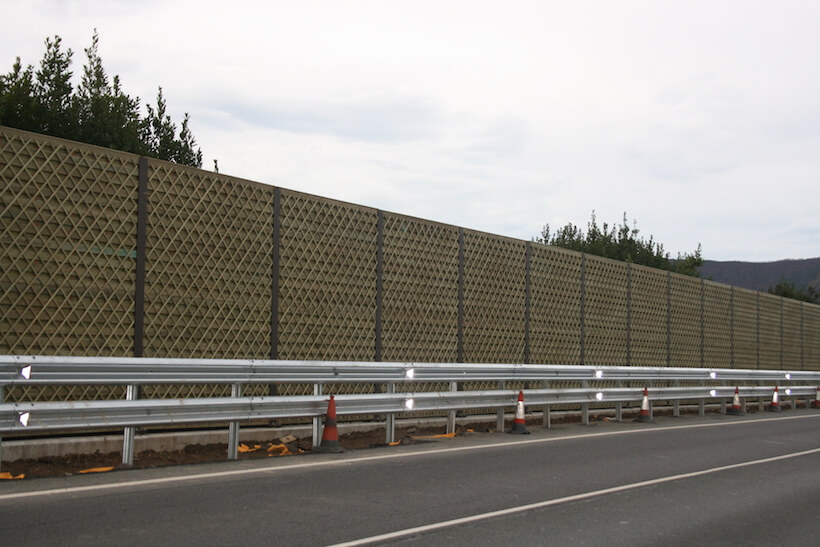
Concrete acoustic screen
Concrete acoustic screens are also a very effective option for noise abatement in railway areas.
Among its main characteristics we find its great stability, and its resistance over time, which is why its maintenance is scarce. This consistency is achieved thanks to its materials: cement, sand, water and gravel or crushed stone, giving rise to a highly rigid structure.
The concrete is supported by metal pillars, which also receive a specific treatment to withstand the passage of time. The anchoring of the steel profiles is carried out on the concrete through bolts of variable diameter and length, depending on the client's needs.
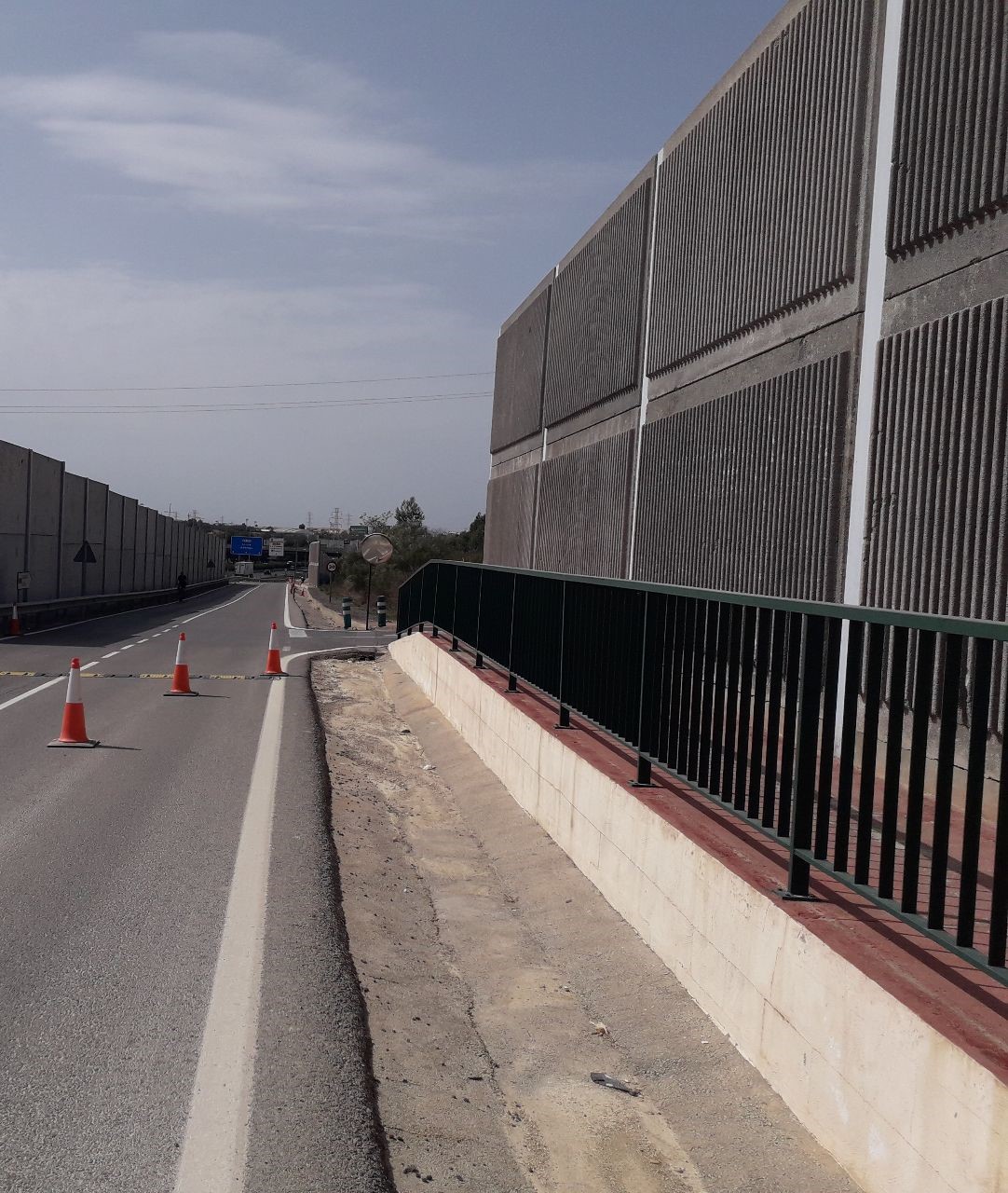
Like the rest of acoustic screens, it also allows maximum noise absorption and excellent landscape integration.Noise pollution is a very serious problem, but ‘invisible’ and fortunately more and more society is giving it the importance it requires to implement effective solutions. Undoubtedly, the installation of acoustic screens to absorb noise on roads and railways is the best option to prevent harmful consequences on the health of people who live near these areas. At Metalesa, we want to be part of the solution with our acoustic screens. If you need our services, contact us by calling +34 96 088 99 44 or send us an email to metalesa@metalesa.com.
How has mobility in cities changed?
Mobility through cities is becoming more and more “à la carte” while ways of transport are increasingly modernizing, thus adapting to the needs of different profiles of people. We see how every day companies offer mobility solutions for cities that adapt their services to the comfort and personalization that citizens are demanding, making them more ergonomic, economical and trying to be as respectful as possible with the environment.
The importance of adapting
Currently we want to move faster, save time, and if possible, with the lowest energy consumption and the lowest economic cost. The proliferation of geolocation technology has enabled the use of applications that help us to know real time the arrival of the bus at our stop or how the traffic is in the city. Many cities, in their quest to become smart and sustainable, have established new urban solutions to improve the use of public transport, and have limited traffic in some areas, even prohibiting the circulation of private cars in downtown areas with a high concentration of users.
This trend has materialized in the deployment of solutions such as bollards or bike lanes, the adaptation of all horizontal and vertical signs, and the offer of subsidies for the purchase of personal mobility vehicles. The response of the citizens has not waited long, and thus we have seen massive purchase of bicycles and / or electric scooters, not only in large cities, but also in smaller towns. Little by little, all these measures integratede into comprehensive sustainable urban mobility plans are working together to create pollution-free urban areas.
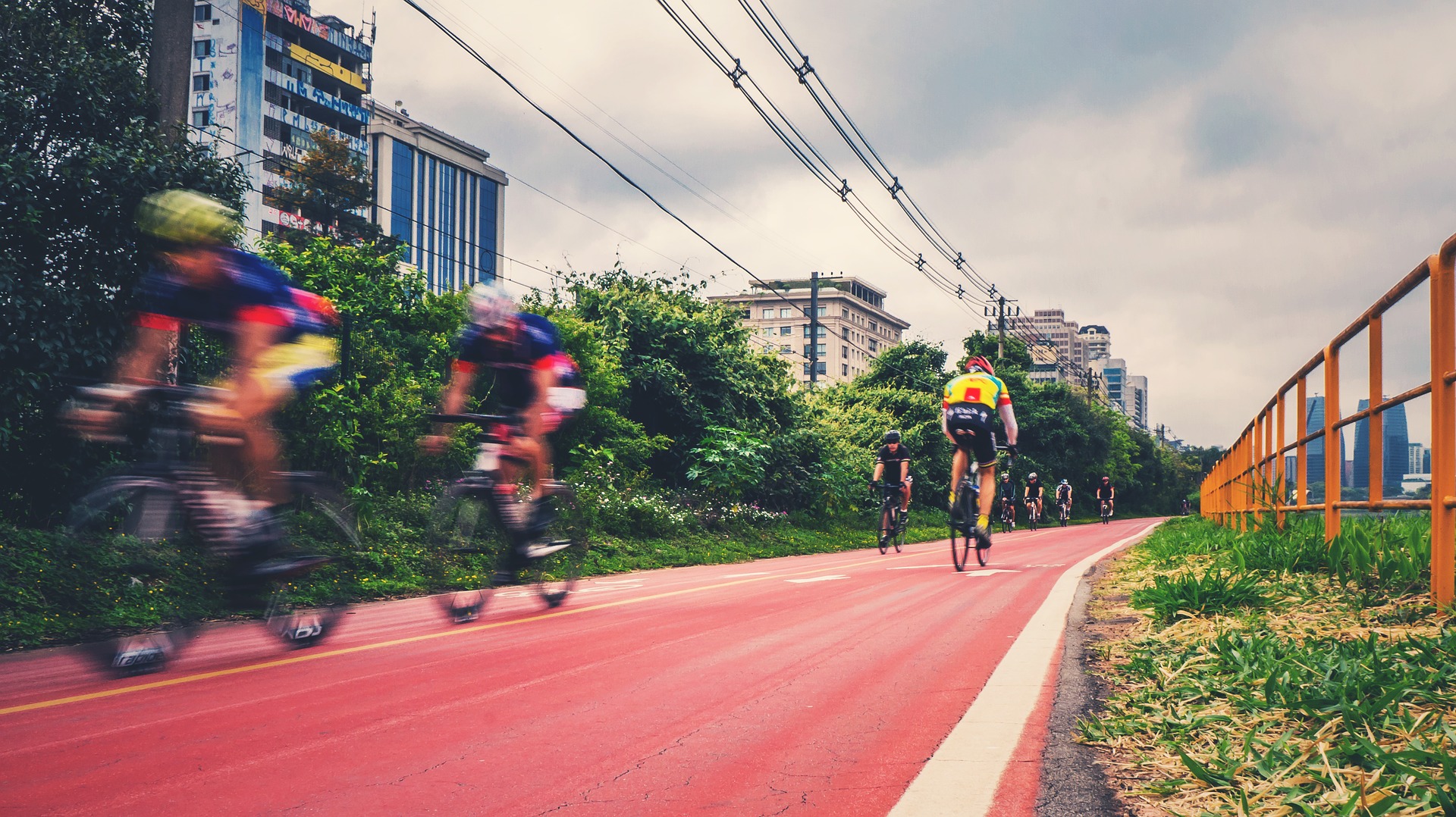
In a society that is increasingly aware of the importance of caring for the environment, and willing to adapt itself to the new times, it has been inevitable that this type of electric personal mobility is in fashion and that it is expected to continue growing. At the same time, this has acted as a catalyst for the industry to innovate and bring new mobility solutions to market.
This set of chained consequences lead our cities into a virtuous circle that reinforces investment in safe urban mobility, either with solutions such as bollards, or with other types of parapets, guardrails or urban containment barriers. In short, minimizing the risk for pedestrians, cyclists, or those who lean towards the electric scooter.
Our urban mobility solutions
Our commitment to society lays on our purpose of saving lives. This has led Metalesa to work for a long time to improve people's lives. Urban solutions to bring an improved safety for citizens in their daily urban mobility, is a key area where we have been concentrating our efforts in recent years. Some of our most demanded products to improve mobility in cities are urban parapets, cyclopedestrian railings and bollards
- The urban parapet, which Metalesa manufactures and installs, is a containment system designed to be installed on urban roads or with a limitation of up to 20, 30 or 50km/h. Manufactured for its perfect integration in the urban areas such as streets, avenues or roundabouts.
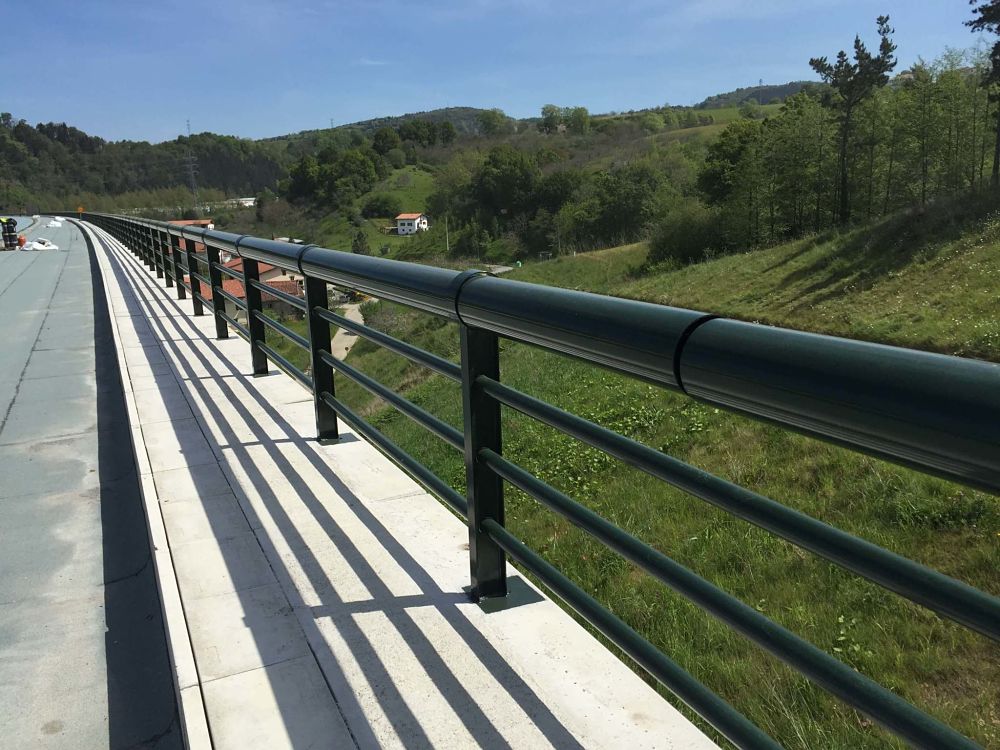
- As for the cyclopedestrian railings, we have a wide variety of models capable of adapting to the road infrastructures of any city. It is an urban containment system in order to protect both pedestrians and cyclists who pass through the bike lane from road traffic.
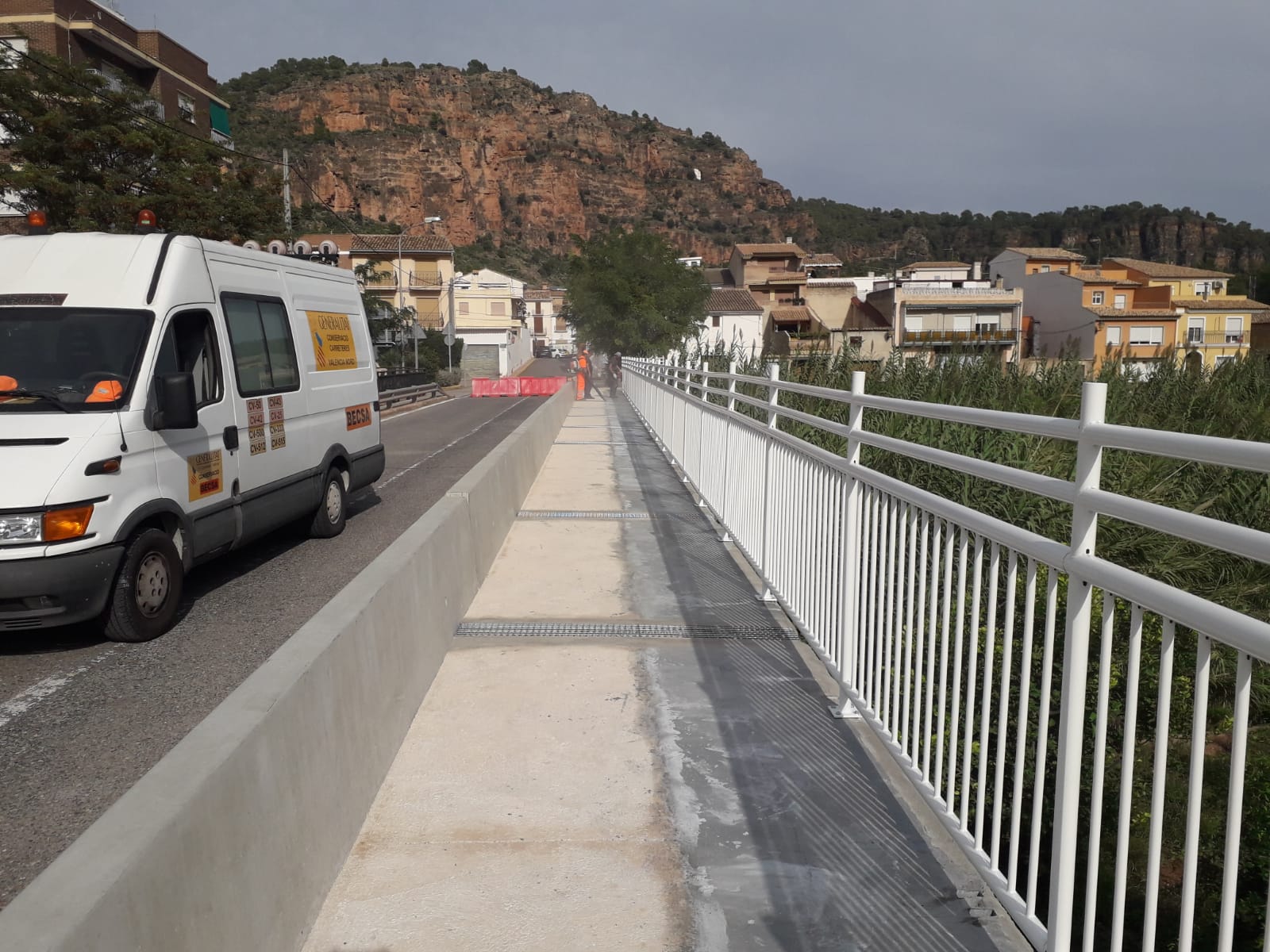
- We also have a wide variety of bollards. Its main objective is to delimit vehicle access to pedestrian, cycling, or leisure areas. To this day, it continues to be a safe bet for the improvement of mobility in cities. We have also carried out a number of installations in private areas of industries or logistics centers.

If you want to put an end to these problems and want a smart solution, don't hesitate to contact us. Our service of technicians and advisers of the commercial department will not hesitate to offer you a proposal that adjusts to your reality so that our service is 100% effective.
World Environmental Education Day
Every January 26th we celebrate the World Environmental Education Day. Obviously, it is not a day of celebration but of awareness instead. As a society we have taken some steps to preserve the environment, but we still have a long way ahead.
On this very necessary day, we seek to sensitize society about the relationship between human development and the conservation of the planet. There two phenomena must go hand by hand, supporting each other and not in opposition as it used to happen a few decades ago. At Metalesa we believe that it is necessary to stop and reflect on this, because we care about people and improving their quality of life.
Origin of World Environmental Education Day
Let’s start by giving context to this article with a little background on World Environmental Education Day.
It has its origin in 1975, the year in which the International Seminar on Environmental Education was held in Belgrade (Serbia). At that event experts from over 70 countries participated and established the principles of Environmental Education within the framework of the United Nations programs. As a result of this milestone, known as the Belgrade Charter, the fundamental demands of Environmental Education were reflected.
Since then, every January 26th, all countries use this day to promote awareness-raising initiatives on regards for the Environment. Specifically, in Spain, the Environmental Documentation and Information Section of the CENEAM (National Center for Environmental Education) produces each year a guide to fundamental resources for environmental education, very useful to begin studying, deepening and investigating, and a basis on which to launch a series of environmental education programs and activities.
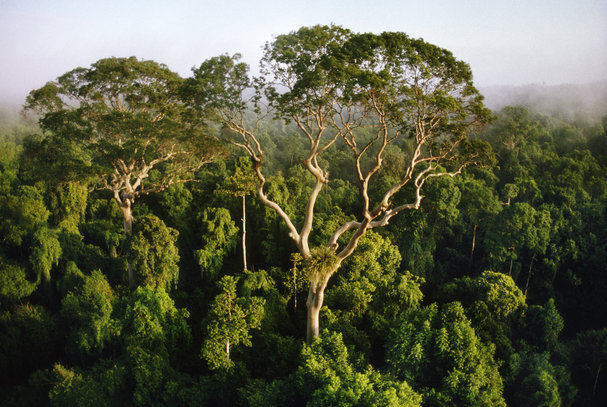
Objectives of environmental education
In general terms, Environmental Education aims to achieve the following goals:
- Awareness: Help people, both individually and collectively, acquire greater sensitivity about the importance of caring for the environment.
- Knowledge: To take care of the environment, you need to know how to do it. The population needs a basic understanding of what it means to be responsible for our environment and the resources we consume.
- Attitudes: It is essential to acquire values and promote interest in actively participating and protecting the environment.
- Evaluation capacity: Help social groups to evaluate the measures of environmental education programs.
- Participation: Help people develop their sense of responsibility by actively participating in this common goal.
Technology and Environment: an essential tandem
Human development understands that the people of a society can develop their maximum potential and lead a productive life according to their needs and interests. The increase in population, the increase in energy expenditure, the increase in the productive capacity of food … all this is very good, but we cannot ignore the fact that it also leads to environmental effects such as pollution, massive cutting of trees, depletion of water resources or global warming.
The mastery of technology to social evolution has meant that, in many situations, this development accelerates these negative consequences. However, it is also true that our actions, and how we use technology, may be part of the solution. But how can technology help reverse them?
Benefits of technology at the service of the Environment
Let’s see some examples of how technology contributes if we propose to improve the environment:
- Recycling: increase the volume of recycling and the efficiency of the recycling process of different activities and materials.
- Design of cities based on Smart Cities models: design of smart cities that satisfy the needs of the population with an optimization of the use of resources. We tell you more about Smart Cities by clicking on this link.
- Development of new forms of energy: friendly to the Environment such as wind or solar energy.
- Development of sustainable means of transport: fuel that respects the environment, such as cars or electric motorcycles.
This list could be very long, as long as the will of the whole of society wants it, because as we have said, an adequate use of technologies can have a positive impact on the protection of the Environment.
Our commitment to the environment
Every company should take into account its environmental footprint, that is, the impact generated by the service or product it offers.
At Metalesa we have always been aware of this. We know that as a company we must provide solutions and be innovative to satisfy one of the priority demands of society: the commitment to the environment and sustainability.
We achieve this task from different initiatives:
Installation of Thermo-lacquering and Zero Discharge Treatment Plant
Many of our products, for example our steel or aluminium acoustic screens, go through the thermo-lacquering process if the customer requires it. The process consists of applying a powder coating to a piece of metal that has been prepared, previously treated, and then cured in the polymerization oven.
Powder coating process is very respectful with the environment as it is a clean coating. The powder paint we use does not contain solvents, and the powder that does not adhere to the part is recovered for reuse. This use of almost 98% represents a reduction in the amount of waste generated.
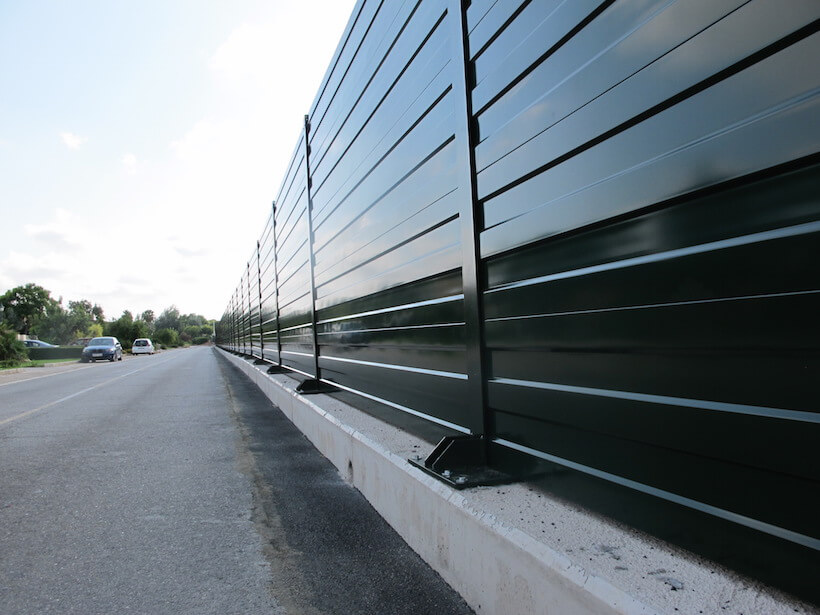
Regarding the zero discharge treatment plant, it is a technology that we use in our facilities in order to control waste and acquire a commitment to continuous improvement with sustainability. The zero discharge treatment plant allows us to contribute to the recovery of aquifers, since it allows us to reuse water in all our industrial processes through a cleaning process by electrolysis. in this way we manage to minimize the amount of water used and we manage to optimize all our resources.
Other initiatives in our facilities that favor sustainability
- Photovoltaic installation: At the end of 2020 we have installed a photovoltaic solar plant of up to 100KW of power on the roof of our factory. Technical studies estimate that with this installation we will produce up to 60% of the energy we consume per year in the development of our operations.
- Replacement of LED luminaires: In all the facilities of our factory we have installed LED lights, with this change we manage to reduce annual energy consumption by up to 15%.
- Replacing diesel trucks with electric trucks: For a long time all our trucks have been electric, therefore they do not produce CO2 emissions.
- We encourage the use of 0 paper: We try to spend as little paper as possible, and we achieve this thanks to the digitization process we are carrying out. We have managed to reduce the use of paper by up to 75%.
- Installation of EV charging points: This is one of the initiatives we have planned. We want to make different charging points for electric vehicles available to our employees throughout our facilities.
- Compliance with environmental standards and guidelines: Through our sustainable commitment, our intention is to achieve official accreditation of standards related to the Environment such as: Standards for Energy Efficiency Management Systems ISO 50001 or Carbon Footprint ISO 14067.
Our products: Acoustic Screens
One of our main products are acoustic screens, barriers specially designed to reduce a problem so harmful to people and animals, noise pollution. At Metalesa we manufacture all kinds of acoustic screens that fulfill their anti-noise function, but we have three models that are especially beneficial for our environment:
Metagreen Acoustic Screen
Rock wool is placed inside the plant screens, which, together with a green plastic mesh, facilitates the growth of vegetation in the style of a vine, generating in a few months a green acoustic wall, optimally integrated into the environment.
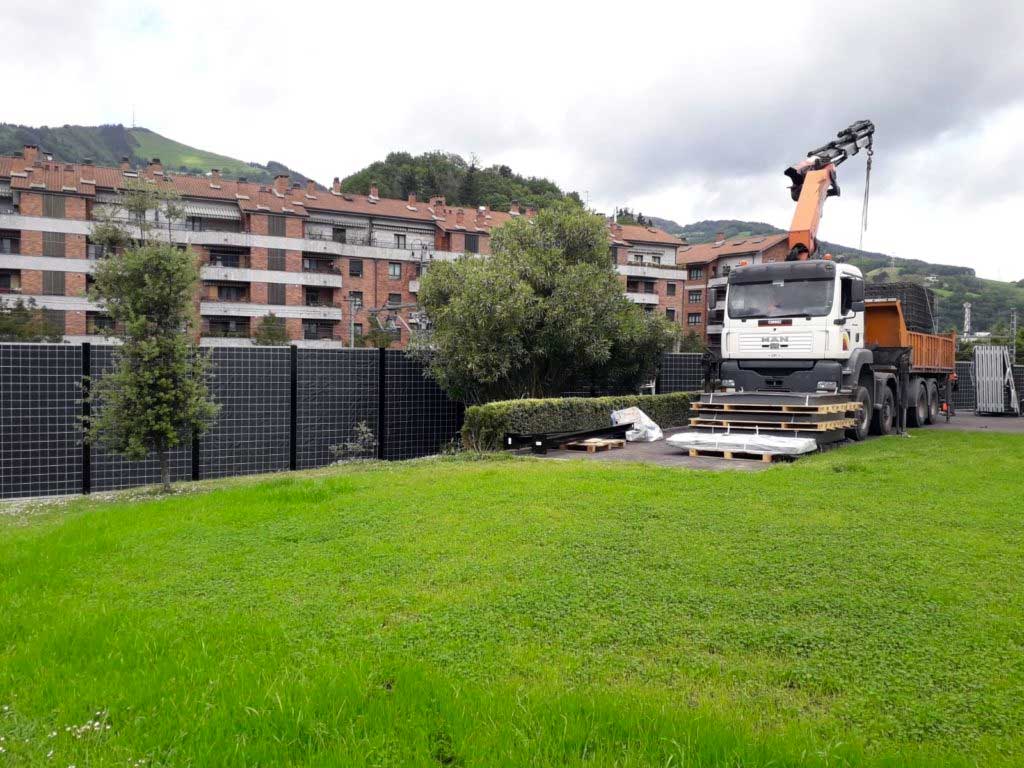
Bird Collision Screen
These types of acoustic screens are specially designed to prevent birds from colliding with vehicles or trains traveling on the tracks. This is how we achieve their preservation and protection of their migration routes.
Screens for wildlife passage
Screens for wildlife crossing are installed in overpasses equipped to protect the passage of fauna and livestock that circulate over roads or railroad tracks. These are wooden panels that are supplied with a chemical treatment that guarantees the preventive and curative action of insects and fungi, as well as solar radiation. Furthermore, the wooden panels optimize their integration into the environment.

To conclude, we will return to the task of World Environmental Education Day. To advance as a society, it is necessary to appreciate the Environment, and it is everyone’s responsibility to learn and internalize correct behaviors about it. Nature is not an inexhaustible source of resources, so we must all put our best efforts together to try to make our actions as less harmful as possible. From Metalesa we have already joined this objective. And you?
Safety in urban areas and on the cycling lanes
As experts in Road Safety, one of our tasks should be to promote greater awareness about the safety of people, both in urban areas and on roads. In this sense, although our products are intended to make people’s lives safer, at Metalesa we intend to go further and we want to do our bit in this ongoing process of awareness.
In today’s post we talk about the safety of cyclists when they circulate through urban areas or roads. Undoubtedly, it is one of the most vulnerable groups that suffer too many accidents, which is a problem that must be solved.
To start with, here there are some figures. In 2014, 75 cyclists died on Spanish roads, in 2015 there were 55 and in 2016 it was reduced to 33. Having said that, although the trend of cyclist accidents seemed to be decreasing in the last five years, the truth is that in May 2017, these figures were already doubled, and in 2020, 36 cyclists lost their lives, a surprising number after long months of confinement.
At the beginning of the article we mentioned that our products are intended to ensure safety. However, people must also do their part to achieve this goal. Here there are some useful tips for both cyclists and drivers to ensure the safety of those both in urban areas and on roads.

Everything a cyclist needs to know to ensure their safety
Although there may be external factors that endanger their safety, it is important that the riders know how to protect themselves:
- To know traffic regulations, and therefore, what you can do and what it is forbidden on the road will allow them to be more aware of the dangers.
- If there is no bike lane on the road, it is preferable to travel on roads with a wide shoulder, much better if they are little traveled.
- The use of conspicuous clothing is recommended to make themselves more visible. Here we also include the helmet color, which is mandatory.
- Check wheels, brakes and lights from time to time. Something as fast as a simple check-up can save a rider’s life. Regarding the lights, it is important to note that they should be used both at the front and at the rear in low light hours. In addition, it is mandatory to turn on the lights when driving through the interior of a tunnel, whatever time it is.
- Use of the rear-view mirror. This device is less common than it should be. Rather few cyclists decide to attach a rear-view mirror to their bicycle, but it is undoubtedly a very useful component to increase safety, and cheap indeed.
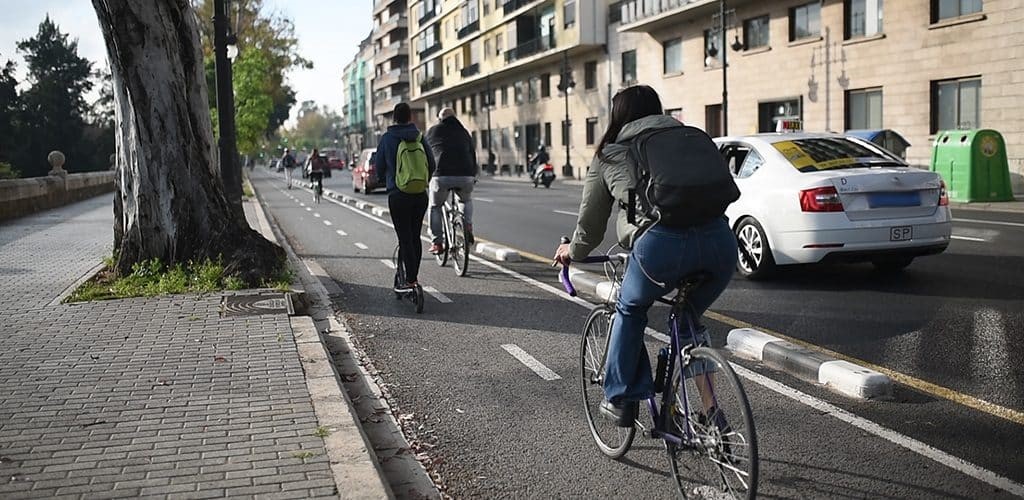
What must a vehicle driver take into account to ensure the safety of cyclist?
- It is important to bear in mind that, when passing a cyclist, the air displaced by the vehicle can throw him off balance. Therefore, when overtaking, at least 1.5m of lateral space must be left as a safety distance.
- If cyclists are observed, slow down and be extremely cautious.
- The horn should not be used to warn the cyclist of the presence of the vehicle because it can scare, distract and cause them a fall.
- It is very important to know when cyclists have priority. For example, a group of cyclists has priority when they have started a crossing or entered a roundabout.
- Only with greater respect for the priority of passage and the safety distance could the number of cyclist victims be significantly reduced.
We are aware that these are quite obvious pieces of advice, but it is not a bad thing to remember them considering that, statistically, most accidents occur precisely because of not complying with these simple tips.
Road Safety Improvements for cyclists through urban planning
Not only are people becoming more and more aware, so are cities, orienting their planning towards more efficient models, both in terms of safety and sustainability. In this sense, the promotion of urban mobility through the use of bicycles entails an ambitious urban reorganization that involves the implementation of cycle lanes. In fact, we are seeing that the cities deploy every day more kilometers of bike lanes.
How do we guarantee the safety of cyclists from Metalesa?
Protection is our goal. That is why we design and manufacture road safety products specially designed for this.
Our M009 cyclopedestrian railing is a restraint system for cyclists that cannot be absent in urban areas or on roads to reduce the accident rate of cyclists.
It is located at the ends of bridges or crowning walls to prevent pedestrians and cyclists from falling into the void. It differs from a normal railing in its height, between 1.3 – 1.5 meters, which prevents cyclists from exceeding it, which is perfectly possible with traditional railings for pedestrians up to 1 meter high.
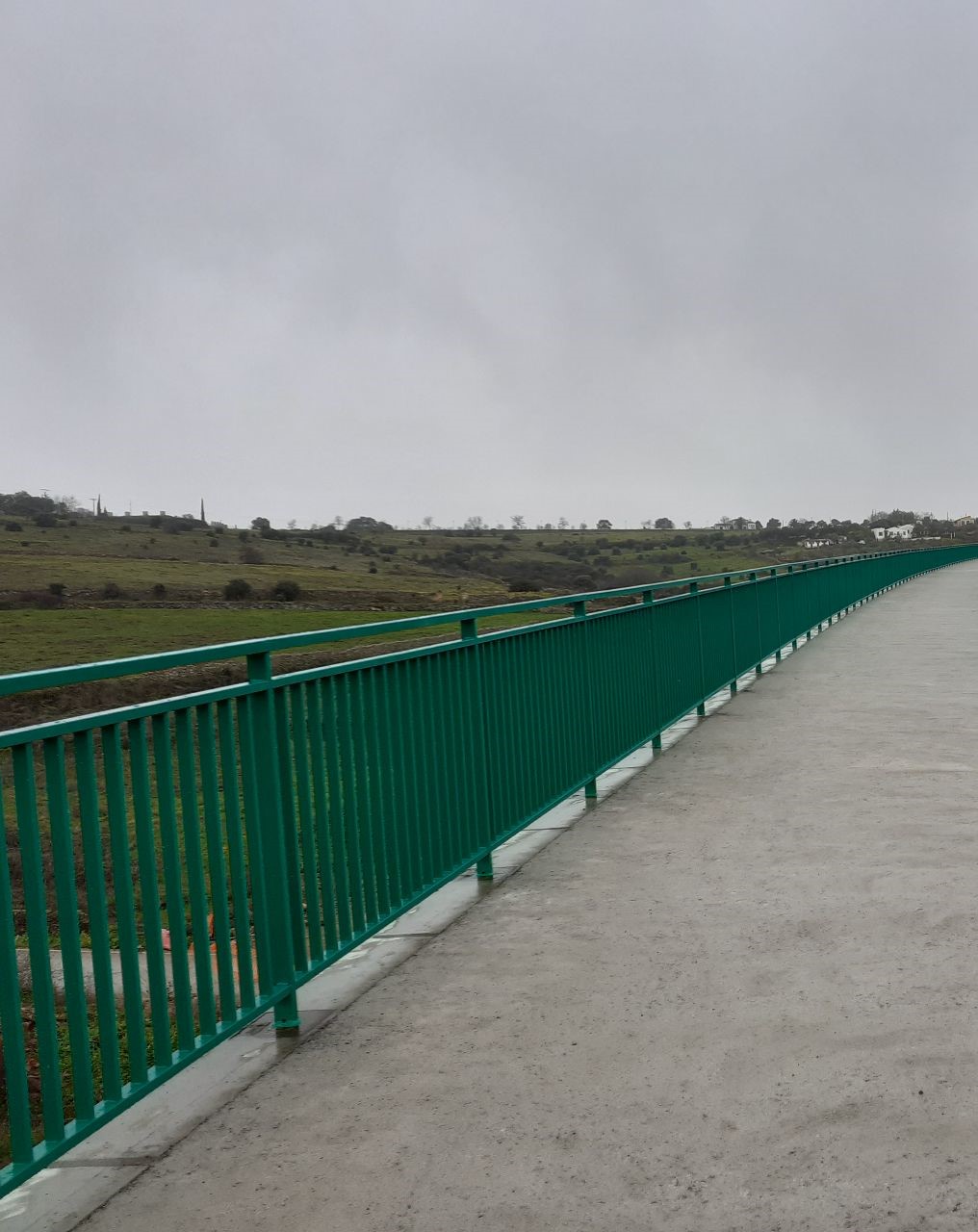
In addition, all the components of the railing are protected against corrosion at the customer’s discretion: hot galvanized, thermo-lacquered or both treatments at the same time.
The thermo-lacquering allows to facilitate the aesthetic integration of the cyclopedestrian railings with the environment, since we can paint them in any color from the RAL chart.
In a previous post we made reference to how 5G technology in cities can help ensure maximum safety. Perhaps a day will come when cyclists will cease to be a vulnerable group thanks to the development of tools based on wireless connectivity. However, at Metalesa, we obviously support technological progress and the great advances that it can bring to road safety, but we also want to take advantage of it to call for the responsibility of each one. Safety is everyone’s business!
En un post anterior hicimos referencia a cómo la tecnología 5G en las ciudades podrá ayudar a garantizar la seguridad al máximo. Quizá llegará algún día en el que los ciclistas dejen de ser un grupo vulnerable gracias al desarrollo de herramientas basadas en la conectividad inalámbrica. No obstante, desde Metalesa, evidentemente apoyamos el progreso tecnológico y los grandes avances que puede aportar a la seguridad vial, pero también queremos aprovechar para hacer un llamamiento a la responsabilidad de cada uno. ¡La seguridad es cosa de todos!
The importance of wall covering in facades and tunnels
Wall cladding in facades and tunnels is one of our most demanded services both nationally and internationally, and at the same time one of the most unknown. For this reason, in this article we want to tell you about the great advantages that wall coverings have and what is the difference between cladding on the façade and in tunnels.
Wall cladding in tunnels
In this case, it is a wall cladding made of galvanized steel sound-absorbing panels, specially designed to deal with noise pollution derived from road and rail traffic, both inside and at tunnel entrances. At the customer's choice, galvanized steel panels can be filled with rock wool, a material with a high sound absorbing capacity that facilitates the rebound of acoustic waves inside, thus trapping much of the sound.
Sometimes, poor tunnel lighting poses a greater risk to drivers. In this sense, the installation of our wall cladding on the concrete walls of the tunnel brings luminosity to the interior, facilitating vision and increasing safety. In addition, any additional signaling or lighting system can be installed on our cladding.
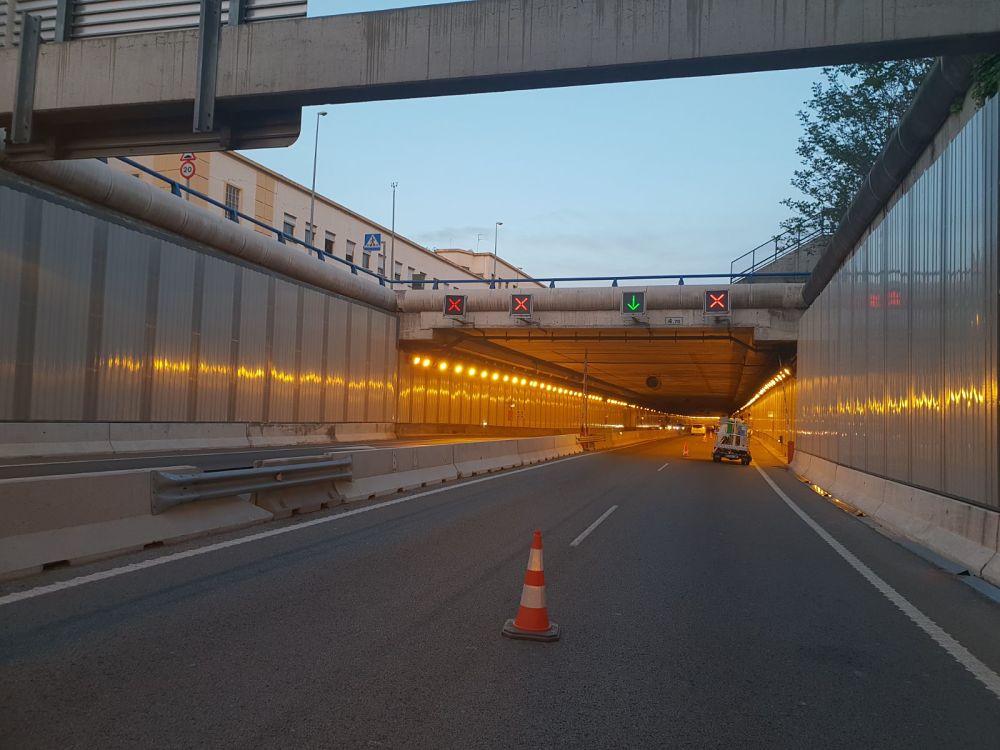
Characteristics and elements of the panels for sound absorbing tunnel coating.
We have several standard construction solutions, configured thanks to the experience of having carried out numerous projects that has helped us to optimize the design and its features.
Our team of engineers studies each project and of steel with the client's specifications, defines the best technical solution. Typically, the cladding has the following elements:
- Panels: made of corrugated and galvanized steel sheet. They can be perforated in case of acoustic absorption requirements. There may be a single front panel or front and rear panels. At the customer's request, its finish can be thermo-lacquered in different colors from the RAL chart.
- Paneles: realizados con chapa de acero grecado y galvanizado. Pueden ir perforados en caso de haber requerimientos de absorción acústica. Puede haber un solo panel delantero o paneles delantero y trasero. A petición del cliente, su acabado puede ser termolacado en diferentes colores de la carta RAL.
- Rock wool: This material is used to absorb sound waves generated by transport systems.
- Supporting structure: It is a wall anchoring system using adjustable rods made up of profiles that allow the panels to be adapted to walls with almost any type of irregularity. We have several bearing systems, in each project the most suitable will be chosen depending on elements such as the state of the wall or the type of coating required.
Advantages of panels for sound absorbing tunnel lining
- Corrosion resistance: we have different solutions depending on the environmental specifications in the area, including up to C5. In addition to being made with galvanized materials, if the client wishes, we can apply primer and / or thermo-lacquering techniques, which protect the coating from the consequences of the passage of time and adverse weather conditions.
- As we have already mentioned, this type of cladding fulfills an important acoustic function, and this is precisely its main advantage.
- Easy installation due to its lightness. High productivity in assembly.
- Its maintenance and repair is also easy in case of damage by accident.
- It is a non-flammable coating.
- It fulfills an aesthetic function as the customization of the color is possible, and it also brings light, unlike the concrete walls to which we are accustomed.
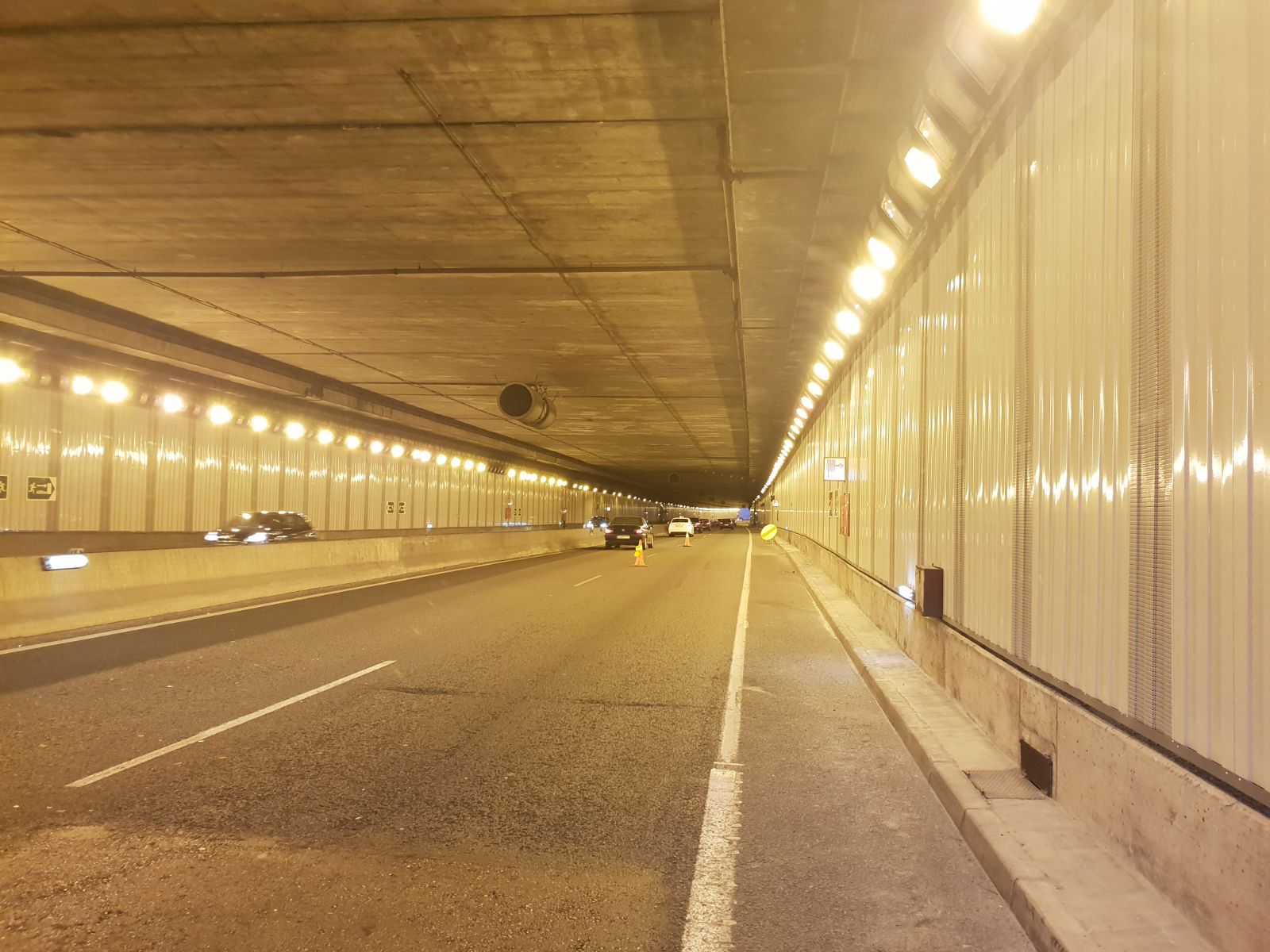
Wall cladding integrated into building facades
In order to minimize the noise pollution produced by environmental noise, such as traffic or the bustle of people, at Metalesa we manufacture and install panels that function as wall cladding on facades, and that are integrated as an acoustic screen in the building .
Below, we show you some images of one of our acoustic wall cladding integration project on the façade of the Atlético Baleares football field. In this case, the panels have been used both to isolate noise from the field, and to prevent noise from the street from breaking into the sports facility.

On the other hand, this product offers a great opportunity to improve the aesthetics of a building through an elegant and quality solution that, thanks to the customization options that we offer at Metalesa, will be able to show off the corporate colors. In this sense, a change to the façade by means of a cladding of these characteristics can make an installation become "something iconic" of an area and give it a certain prestige. Without a doubt, the Atlético de Baleares field is proof of this.
Characteristics and elements of panels for sound absorbing coating integrated in facades
In the same way as in the case of tunnels, we have several standard construction solutions applicable to the integration of acoustic coatings in facades. Our team of engineers will define the best technical solution according to the customer's specifications.
The elements that make up this solution are usually the same as in the case of tunnels. The main difference is usually in the bearing structure, which must be defined ad-hoc for each project, since it is not the same to anchor acoustic panels to a low-rise wall but with great vibrations due to circulating traffic, than to a wall. of a high-rise building and normally without these vibrations.
Advantages of wall cladding on facades of urban buildings
The facade is the exterior wall of the enclosure or vertical closure that surrounds. It is one of the most important elements of the construction along with the roof. Both act as a barrier against external weather factors
Providing the facades of the infrastructures in urban areas with a facade cladding is essential, as it is one of the most important elements of its construction due to its acoustic, aesthetic and climatic function.
Acoustic and mechanical properties of our panels
The acoustic properties of our panels have been evaluated according to EN 1793-1 standards, obtaining maximum acoustic absorption and insulation values. Any acoustic product manufactured by METALESA SEGURIDAD VIAL complies with the requirements established for CE MARKING in compliance with annex ZA of the EN 14388 standard.
Regarding mechanical behavior, the panels are tested according to the EN 1794-1 standard, having obtained very high loads in tests carried out in accredited laboratories.
If you are looking to use wall cladding in facades or tunnels, contact us and we will give you a solution that suits your needs. Call us at 96 088 99 44 or send us an email to metalesa@metalesa.com
Does 5G sounds familiar to you? How can you help the cities of the future?
Even if you don't know exactly what it is, you've surely heard of something called '5G'. 5G connectivity will be the fifth generation of communication networks, and will progressively replace the current 4G network. Currently, we already live in a hyper-connected environment and in cities designed under smart city models specially built to make life easier for people, respect the environment, and in general, to evolve towards more efficient cities in every way. But 5G connectivity opens the doors to a new world where we can go much further.
Normally starting in urban environments, this new generation of wireless connectivity allows the deployment of an immense network of sensors and interconnected communication nodes that will be able to satisfy new needs, for example, improvement in road safety. But before we get to that point, let's go in parts.
What are the advantages of 5G connectivity?
- More speed: Technological revolution and speed go hand in hand. With 5G connectivity you can navigate up to 10 times faster than with current 4G networks. This will not change our lives in terms of the level of service to which we are accustomed when we surf the internet from our Smart Phone, but it represents a differential change for the operation of services in which immediacy is critical.
- Less latency time: Latency refers to the response time of the network, which will allow us to connect practically in real time, without waiting.
- More devices connected at the same time: Have you ever been to a massive concert or a sporting event and have run out of coverage? These limitations are normal with the 4G network but we will forget about them with the 5G.
But this new technology goes far beyond being able to connect many mobile phones at the same time; Any electronic device may be connected, for example, vehicles, urban equipment, industrial robots, or any device that we have at home.

5G will improve the mobility of cities. How?
Increasing security in cities is one of the potential applications of this new hyper-connected era. In this sense, from Metalesa it seems essential to know current and future technological trends, since, like any other business that has traditionally been disconnected from digital technology, the deployment of the 5G network will radically transform the way we understand mobility, urban or interurban, enabling a new world of possibilities for improvement in Road Safety. Undoubtedly, this 5G technology will be a turning point in the user experience and in the services provided by a company like ours.
Reduction in the number of accidents
As we have already mentioned, 5G will considerably reduce the response time of any wirelessly connected technological device, which facilitates better and more efficient traffic management and safety at the wheel.
For example, a car will be able to detect pedestrians or cyclists from a distance, thanks to wireless technology that will allow it to communicate with sensors located at key points in cities: traffic lights, streetlights, urban parapets, bollards, acoustic screens, cyclopedestrian railings, etc ... The fully autonomous car is closer than we think.
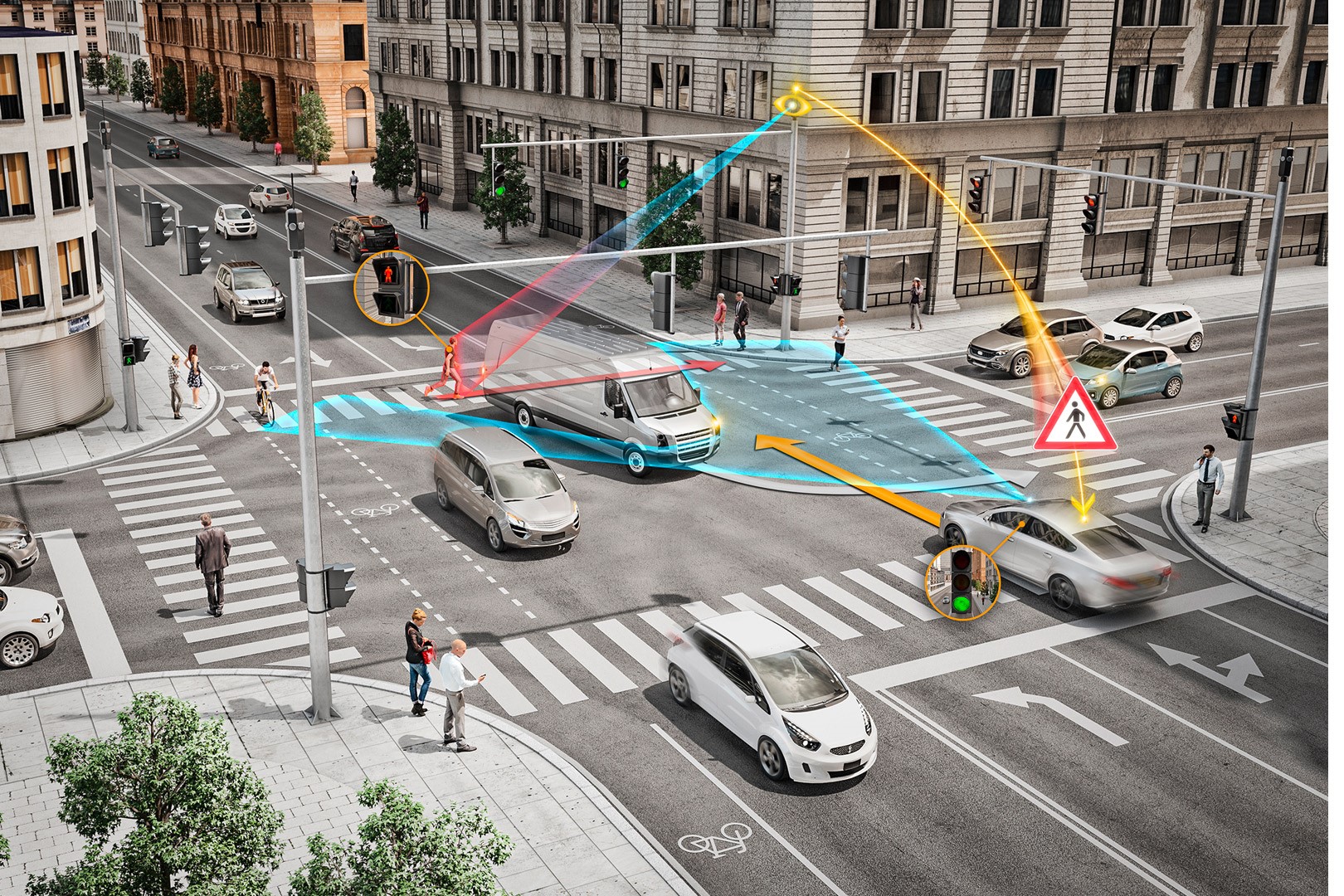
Just as cars will communicate with street furniture, city traffic itself will benefit from being able to adapt the circulation of areas with higher traffic density to other less congested areas.
5G connectivity will enable greater dynamism and increase efficiency in infrastructure management both in cities and on roads, contributing beneficially to a sustainable commitment. There are no limits to imagine how digital technology can be implemented on parapets, transitions or imposts, and of course on any element of railway equipment.
Great capacities for data processing
The goodness of 5G technology will be leveraged on the ability to deploy a data processing infrastructure that allows transforming a growing volume of data into useful information for decision-making and city management, in such a way that it offers an effective service to the citizen.
We have been talking about Smart Cities for decades, and although we are increasingly living in a more hyper-connected environment, we still have a long way to go to become a 100% autonomous society free of dangers. Be that as it may, citizens also have our share of responsibility, although technology is making our lives easier and safer every time.
From Metalesa we want to mark a change in society and help develop products for the Smart Cities of the future.
And you, how do you imagine the city of the future?
Discover our solutions in Railings
Protection is our goal, that has always been our motto and the purpose for which we work. This translates into offering the best protection systems to society, whether in our immediate environment, or in the countries where we market our products.
In today's post we will specifically talk about our range of handrails, intended for various functions, from pedestrian protection, limiting passage areas in railway infrastructures, to install on bridges and viaducts acting as a barrier to avoid unwanted falls, supports in stairs, and many others.
Guardrail types
Barandillas de acero Steel railings
Steel railings are pedestrian restraint systems, which are installed in urban areas, railways, or on highway bridges. It is important to note that they are not designed or tested to contain vehicles, for that are the META13 and META16 metal parapets.
The steel railings are easy to install and, if the client so requires, they can be integrated with the landscape thanks to the wide variety of models, finishes and thermo-lacquered colours that we offer in our catalogue.
In our catalogue, you can find a wide variety of models that we manufacture as standard and of which we usually have stock.
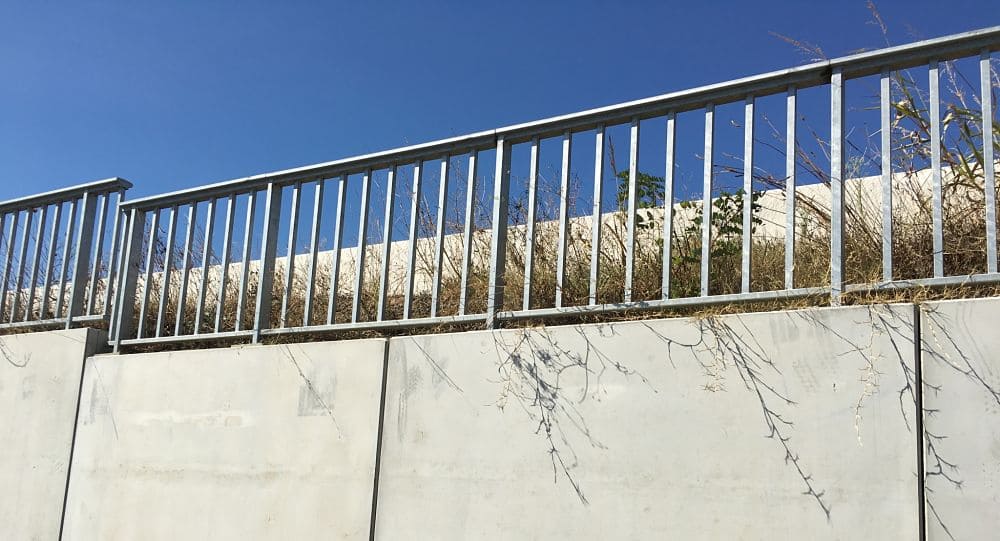
Stainless steel railings
Stainless steel railings are also used to ensure safety in areas where people pass by in infrastructures, for example, in train or metro stations. But their aesthetic appearance makes them very appropriate for any type of urban area or for private facilities such as industries or shopping centers.
Although the most common railings consist of handrails, cross bars and vertical posts, we have at our customers' disposal a wide variety of models with very attractive unique designs for all types of environments. In any case, we are always open to making custom designs to order if the client so requires.
Stainless steel railings stand out for providing a modern look in any environment and, furthermore, one of their great advantages is their durability and the almost absence of maintenance and cleaning.
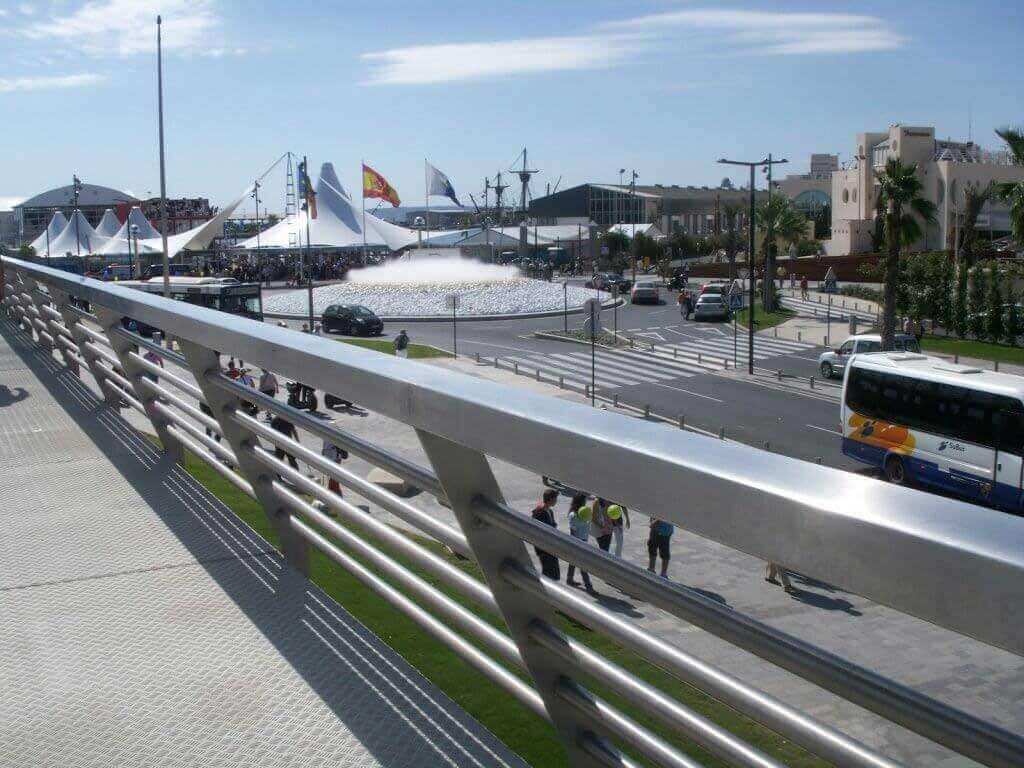
Railings with steel cable
Without a doubt, the railing with steel cable is an elegant option. The steel cables give a modern touch to the environment, increase visibility through the railing itself and facilitate its integration in any place given its minimalist profile.

Railings with perforated sheet
In the same way as metal railings with steel cable, railings with perforated sheet metal also present a very attractive appearance for installation in cities, since they can be manufactured with any perforated design in the material. Depending on the type of perforation, you can create a design that provides safety to the pedestrian without sacrificing aesthetics in streets and railway areas.
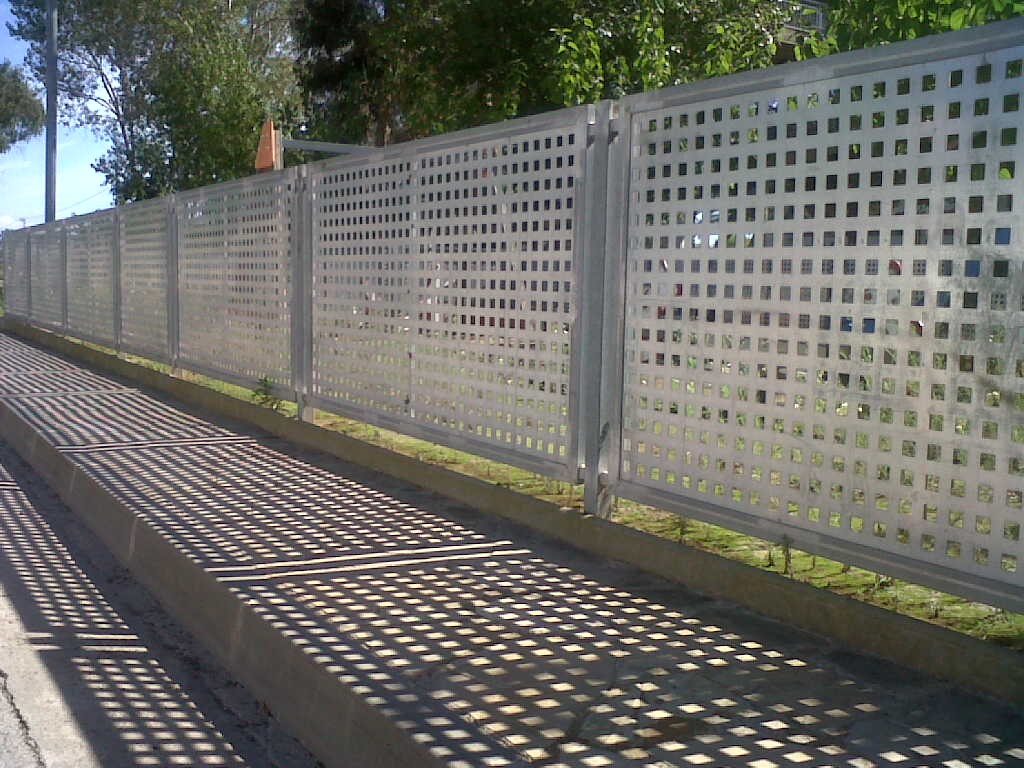
Anti-Corrosion treatment in our Railings
At Metalesa, all the railings that we design and manufacture follow current regulations and the highest quality standards. Since they are products destined to remain mainly in the open, being victims of the adversities of the climate and the passage of time, all our railings are subjected to anti-corrosion treatments that make them very resistant to all types of environmental aggressions. All our railings can be finished in thermo-lacquered, galvanized, or both procedures combined to offer greater resistance to weather conditions.
Thermo-lacquered in Railings
The thermo-lacquered finish is especially suitable for railings that are outdoors. A powder paint coating is applied to the pieces that make up the railing and they are placed in the oven at 220º to seal all the pieces. With this procedure, finishes with a plasticized look are achieved and with the possibility of providing the railings with finishes with different colors.
Hot dip galvanized in Railings according to ISO 1461
Galvanizing is a finishing technique which applies extreme heat to iron or steel pieces to immerse them in molten zinc at 450º. When immersed, this coating is applied both inside and outside the piece, thus offering a complete coating on the entire set. Thanks to this procedure, the railing is sealed and more difficult to rust, being resistant to environmental humidity, extending the useful life of the product in coastal environments.
Galvanized and Thermo-lacquered on Railings
If you want a complete coating, we can apply both finishes. First, zinc galvanizing is applied to the pieces to cover them both indoors and outdoors and then thermo-lacquering is applied to offer a second powder paint coating to give the piece a touch of color. In this way we can manufacture parts that are resistant in the most aggressive environments.
En el caso que estés buscando soluciones de barandillas de acero para ciudades, puedes contactar con nosotros y nuestro equipo comercial podrá darte una solución que se adapte a tus necesidades. Además, también fabricamos barandillas de acero a medida que se adaptan a las necesidades del entorno. ¿Hablamos?
In the event that you are looking for steel railing solutions for cities, you can contact us and our commercial team will be able to give you a solution that adapts to your needs. In addition, we also manufacture custom steel railings to suit the needs of the environment. We speak?
World Urban Planning Day: The importance of sustainable planning in cities
The growth of human concentration in cities and the increase in housing and traffic in urban areas are social phenomena that we have been witnessing for decades, and to which urban planning has to provide solutions. But not just any solution is worth it.
As cities grow, more needs and challenges are presented to us, and the environment is undoubtedly affected by this, a fact that we cannot afford in today's society. That cities grow is not a problem in itself, they simply have to expand and evolve, increasingly thinking about Smart Cities models, based on citizen collaboration, planning, creativity and of course, taking advantage of technology to be more sustainable. Only in this way is it possible to achieve urban and social innovation that generates the necessary efficiency in cities.
How can we achieve a more sustainable city through urban planning?
Construction of recreational areas or 'healthy enviroments'
More and more people are concentrated in cities, which generates a high concentration of people in very specific areas, where the environment is harmed, and consequently the quality of life of its inhabitants.
By healthy spaces we refer to areas such as parks, squares or any type of urban recreational areas that help dissipate population concentrations. In this sense, although urban planning plays a fundamental role, it is also necessary for people to become aware. A great example in the city of Valencia is the old riverbed of the Turia River, a green space almost 10km long that runs through the center of the city and guarantees a lung of oxygen for all its inhabitants.
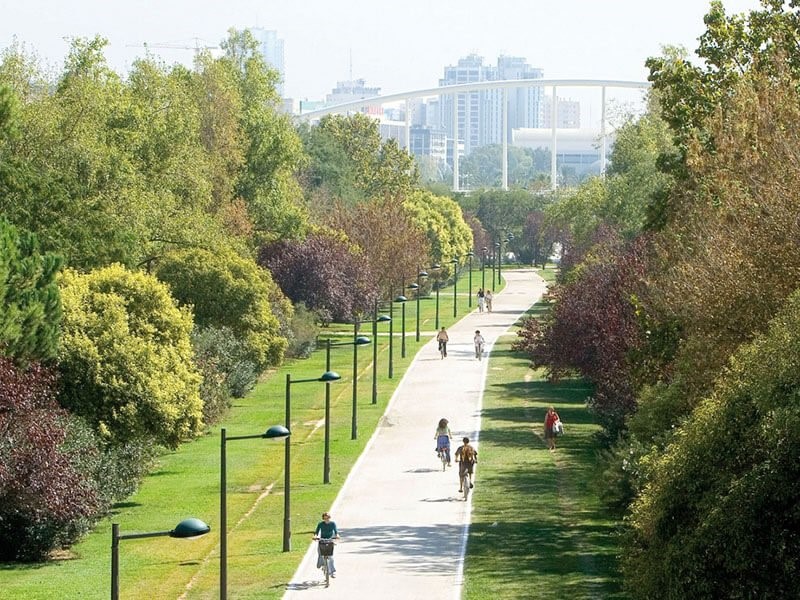
House Building
As we have mentioned before, more and more people are concentrated in cities, so it is necessary to expand the urbanizable areas. The problem is that sometimes there is no choice but to build in areas close to infrastructures such as roads, railways, airports, or industrial zones. Any of these scenarios introduces different risk factors that significantly damage the quality of life of the people who occupy these areas.
In this sense, one of the decisions that should be included in urban planning is the installation of acoustic screens in urbanizations where an acoustic study determines that they are areas susceptible to excessive noise.

Urban Mobility
In a recent post we talked about mobility and safety solutions in urban environments, given that traffic problems and challenges are beginning to emerge as a priority for city managers.
In fact, many cities are embarking on processes of adaptation to new formulas for sustainable mobility. For example, for many years now, a more sustainable awareness of urban mobility has been promoted through the use of bicycles.
This is proven with the fact that most cities have an urban reorganization underway that includes an ambitious plan for the implementation of cycle lanes.
On the other hand, the social phenomenon of electric scooters is here to stay. Currently scooters circulate on the bike lane, but who knows if in the future specific urban routes will be planned in order to guarantee the differentiation of vehicles and safety in urban mobility. It is precisely these types of issues that are intended to be made visible and promoted with World Urban Planning Day.

Innovation through urban design: the drive towards the sustainable city
Throughout the article we have spoken to you in terms of ‘urban planning’. However, the true engine that allows sustainable development based on the characteristics of a Smart City, on the design for social innovation or ‘social design’.
Innovation and urban planning by the hand of the World Design Organization (WDO)
World Design Organization is an organization that is dedicated to promoting industrial design as a profession capable of generating products and infrastructures that help create a better society, with a special focus on the environment.
The WDO recognizes cities for their effective use of design to stimulate economic, social, cultural and environmental development; among which Valencia is included as the World Capital of Design 2022.
The objective of this initiative is to turn design into a tool for sustainable social and economic development. In this sense, design is essential to improve people's quality of life and act as an agent of change. It is about finding and gathering creative proposals that are capable of giving relevance to social design and urban innovation.
In addition, although from the name of the project it seems that everything begins in 2022, it does not. The mere fact that Valencia has already been chosen as the future World Capital of Design, is already producing collective synergies to give visibility to the problems that concern urban areas in order to give them solutions working from the local to the global.
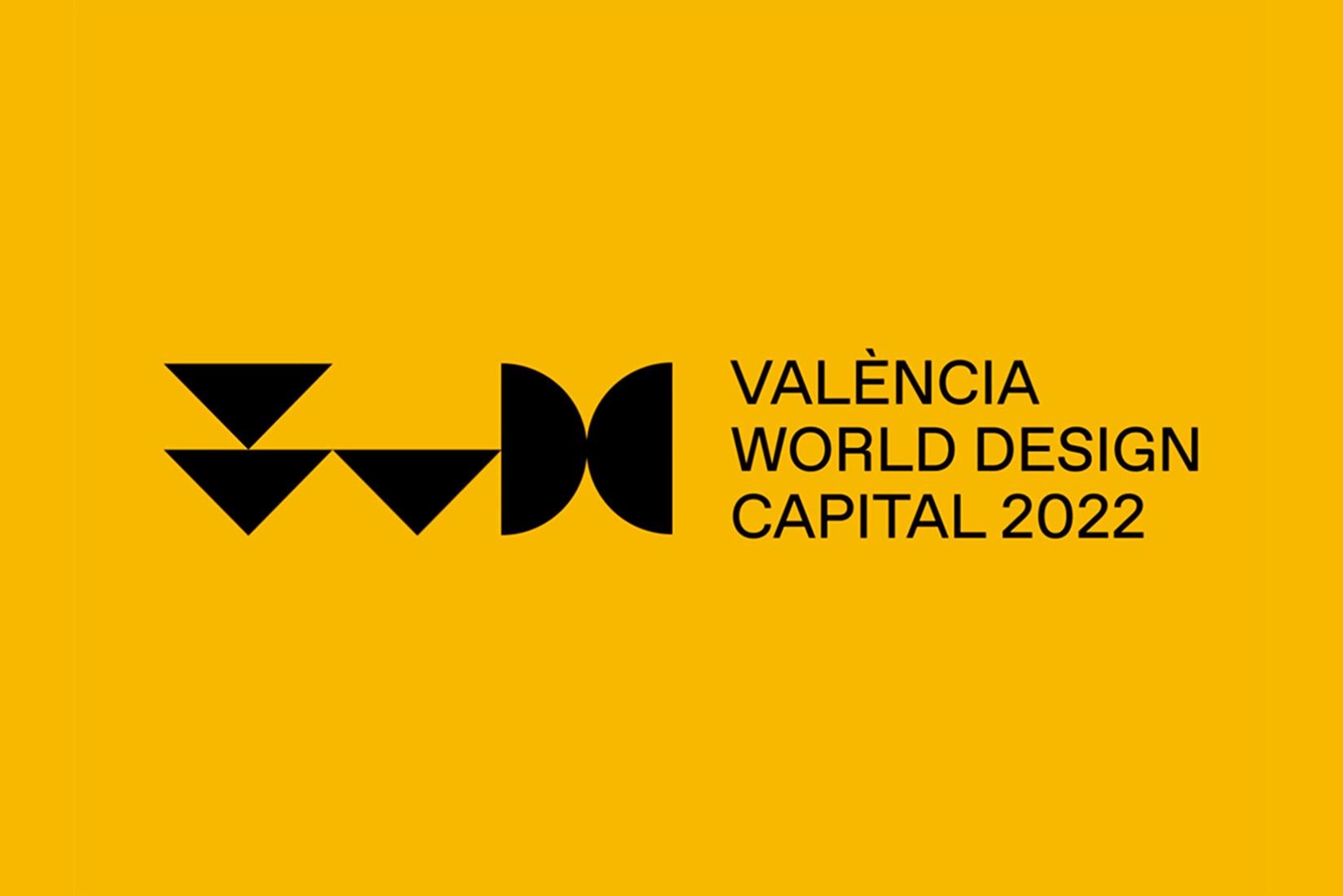
The improvement of the environment implies research and development of new urban formulas, to which social design is capable of providing answers that benefit groups. Without a doubt, our cities are changing for the better… Thanks to transcendental proposals full of creativity, design and innovation.
Protect your facilities with our enclosures and fences
At Metalesa we want to be present in people's lives to make it much easier and guarantee their protection, but we will never do it in an intrusive way. Our products are integrated into roads, railways or urban areas in such a way that, although we do not make direct use of them, they are latently around us, guaranteeing our safety.
Acoustic screens, parapets, railway equipment... We have told you a lot about them on our blog; In today's article we will talk about enclosures and fences, and their applications to protect people in different areas.
Types of fences
Metal fence
At Metalesa we design, manufacture and install metal fences that serve to close any type of space. In addition, all metal enclosures undergo an anti-corrosion treatment either hot galvanized or thermo-lacquered, processes that ensure the good condition of the product over time and against inclement weather.
Vandal Fence
As its name indicates, these types of fences are used to close areas where there may be some type of conflict or security breach, and access must be limited, especially at night, guaranteeing the protection of both people and the premises.
Vandal-proof fences are normally made up of a metal module of the electrowelded or deployed type in its upper part, and of profiled sheet in its lower part. Any other design provided by the customer can also be manufactured. Our team of engineers will be in charge of carrying out the necessary structural calculations to guarantee its functionality and robustness.
Electrowelded fence
We manufacture a wide range of mesh models: smooth, folded, square, rectangular, galvanized, thermo-lacquered ... It is a product that has so many options that it is easily adaptable to any environment.
It consists of the following elements:
- Electrowelded mesh in superimposed wire panels and welded together.
- Round, square or rectangular tube metal posts.
- Fixing elements: tamper-proof screws, union clamps, self-adjusting covers, and other fastening parts depending on the model.
Applications of our enclosures and fences
The installation of enclosures and fences is an element to take into account in some areas that we will now detail. In all of them we benefit from the security and orderly qualities of the different separation spaces.
Fences for the industrial field
In industries we find areas that are especially dangerous for people, or that require special protection for the goods they keep. Therefore, it is necessary to exercise extreme caution with fences that delimit its perimeter and channel its access through the points defined at the scheduled times.
We have many types of fencing for the industrial field, as an example, we list the following:
- Perimeter security fencing
- Pedestrian Fence
- Column protection fence
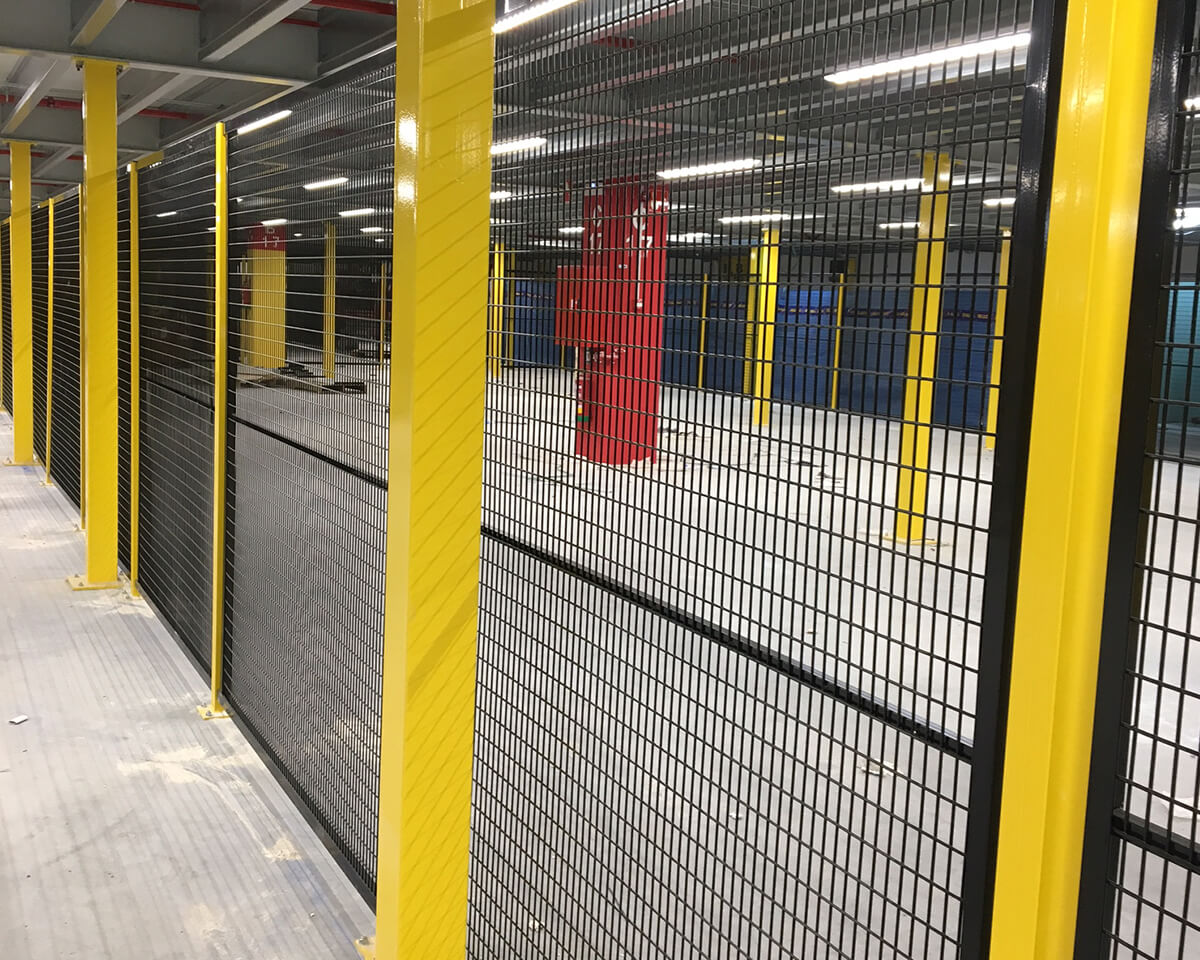
Enclosures and fences for the educational field
More and more university campuses decide to install an enclosure that surrounds the entire perimeter in order to delimit the accesses to the campus, guaranteeing the safety of students and teachers. In addition, it is also useful as an anti-vandalism fence, since it makes it impossible to enter the enclosure at night.

Enclosures and fences for urbanizations
Installing fences in some urban environments is essential, either to guarantee the privacy and security of the tenants, or to address the acoustic problems in the area. In this case, the fencing can be made up of acoustic screens.
In this sense, acoustic barriers, in addition to serving to absorb noise from cars, the bustle of people ... They also guarantee privacy and offer an aesthetic image to the urbanization.
At Metalesa we have a wide variety of acoustic screens also designed to be installed as fences in urbanizations. Methacrylate screens, wooden or metallic acoustic panels are the most demanded for their functionality and their adaptability to the environment.
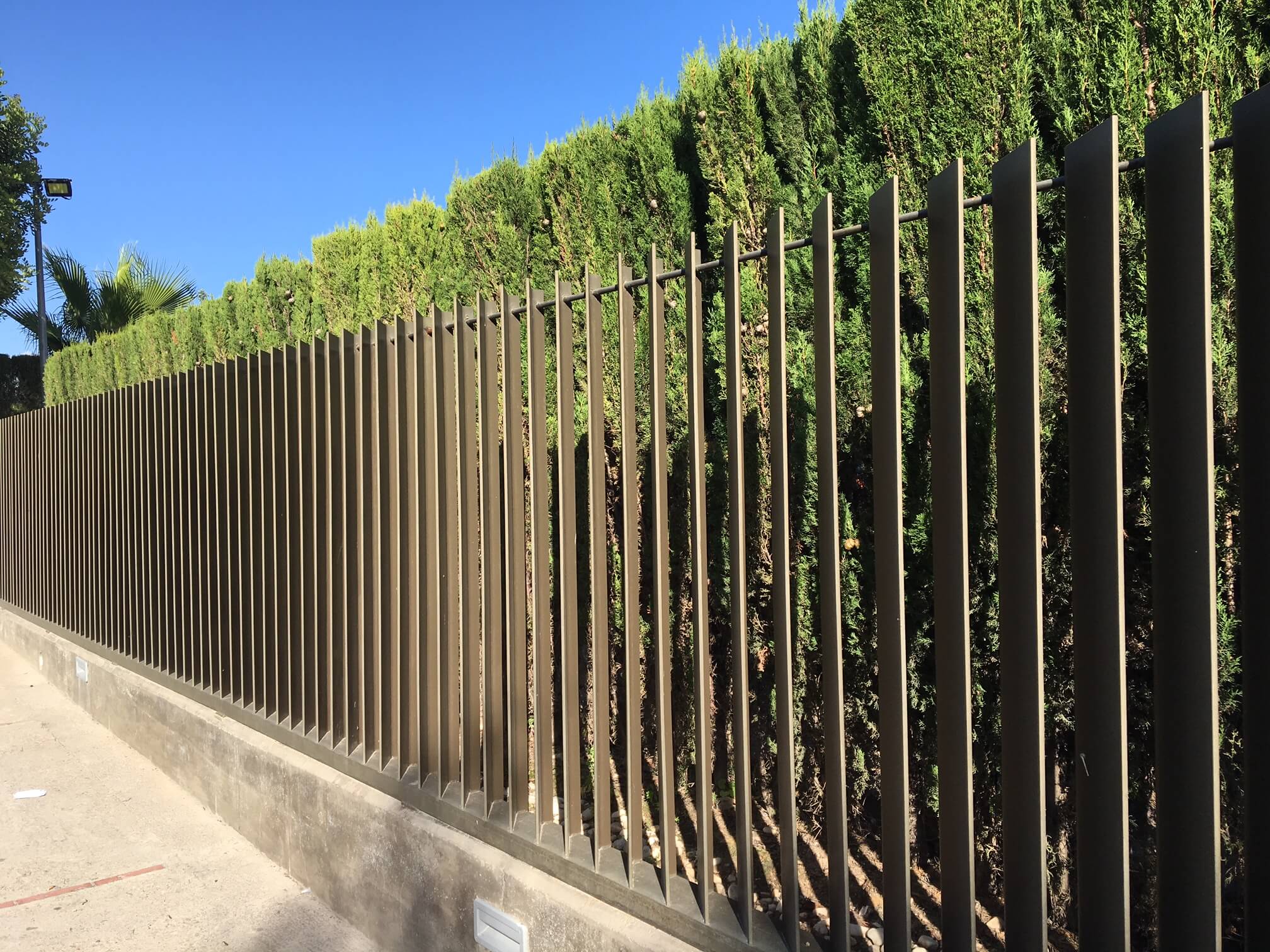
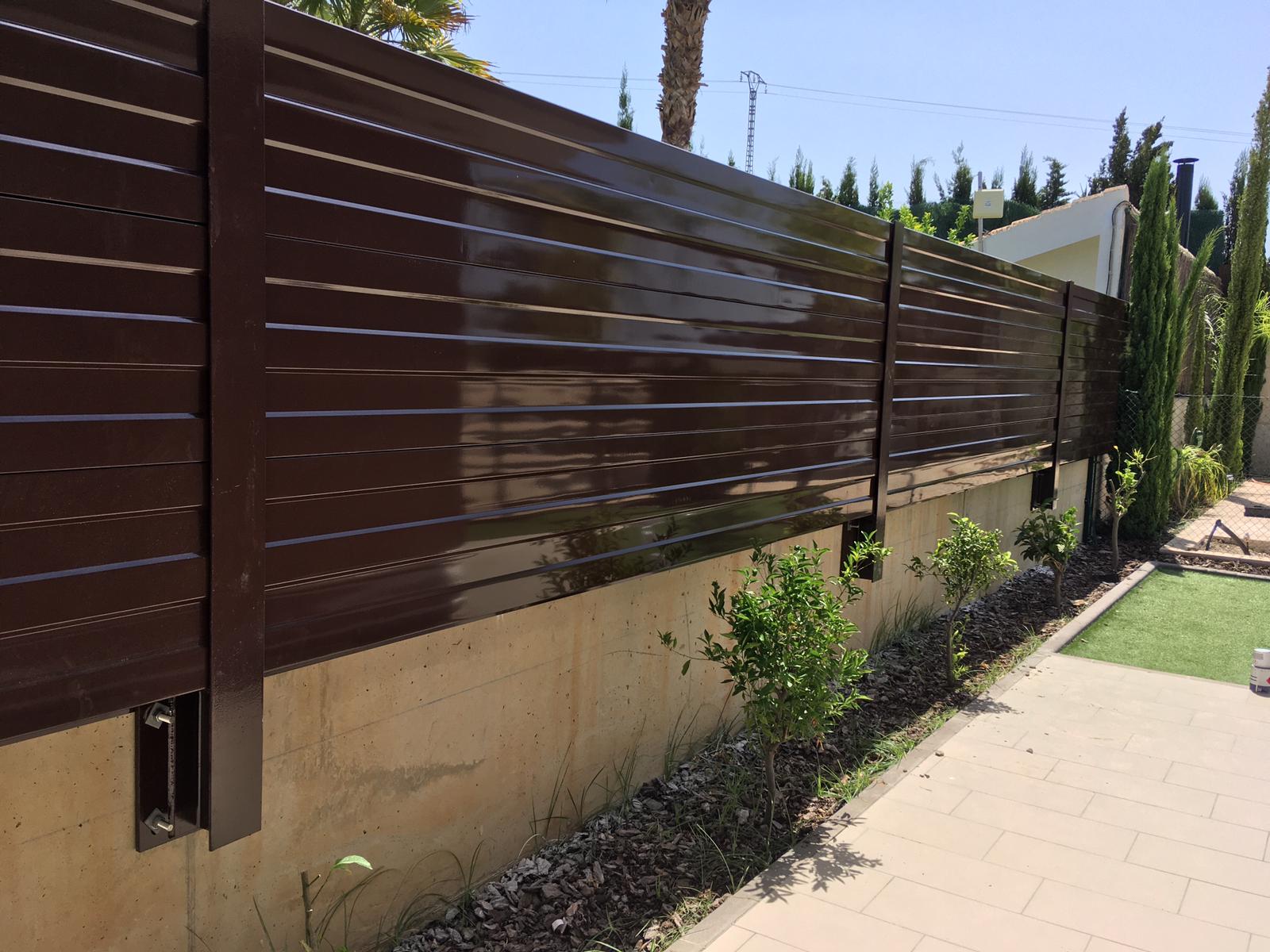
Enclosures and fences for the railway sector
We have a wide range of railway equipment, and in this post we highlight the fences and enclosures for railway areas:
ADIF type fences
In order to guarantee safety at the crossing points in railway infrastructures operated by ADIF, at Metalesa we have a complete range of specialized security systems that comply with the quality standards set by the network administrator.
With our range of ADIF-type railings and fences we can create a complete protection system within railway infrastructures. When a project of these characteristics is presented to us, we carry out a study of the needs of the layout and manufacture any element that may be required to order.
Different anticorrosive treatments can be applied to our entire range of railings and fences type ADIF, each of which offers a different type of protection.
Depending on the characteristics of the project, we can apply a hot galvanized finish, a thermo-lacquered finish or a mixed application for more aggressive environments.

Fences and enclosures for stations
Train, metro or tram stations need robust enclosure systems that are resistant to the high volume of traffic, and at the same time comply with the current regulations on rail matters set by the network operator.
Regarding train stations, whether long-distance or regional, high-speed or not, we have a wide variety of enclosures that we can manufacture on request with standard models that we have supplied in many works, or adapt to the requirements of draft.
In any case, any design can be subjected to a wide variety of anti-corrosion treatments to provide it with the appropriate layer of protection against humidity and oxidation according to the environment in which it is installed.
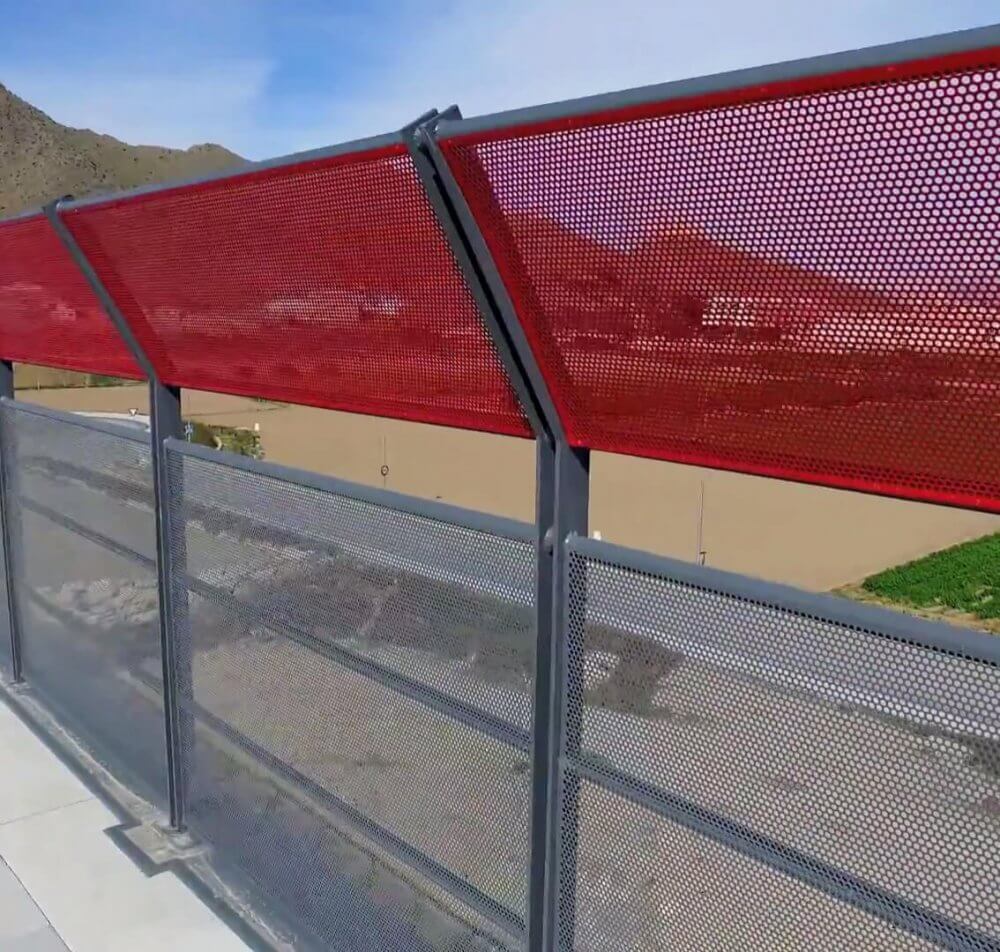
Do you need fences and enclosures for any of these areas or other applications? We at Metalesa know how to help you. Contact us by calling 96 088 99 44 or sending an email to metalesa@metalesa.com
How does Metalesa support our commitment to sustainability?
Contributing to the improvement of people’s lives is our general objective, but in today’s article we aspire to be much more specific, explaining specific initiatives that we carry out.
As you know, at Metalesa we take care of designing, manufacturing and installing road safety systems, urban protection systems and anti-noise equipment. But we are also aware that, as a company, we must provide solutions and be innovative to satisfy one of the priority demands of our society: a commitment to the environment and sustainability.

More and more sustainable facilities
Little by little, our facilities are evolving adopting measures that favor sustainability and reduce environmental impact, reflecting our commitment to preserving the environment.
Photovoltaic installation
We have concluded the installation a photovoltaic solar plant on the roof of the factory with which to install up to 100KW of power and be able to provide service to the factory in a remarkable way, especially in the months with the highest light incidence.
The preliminary studies of the project allow to advance an average annual external energy consumption savings of 60% with green and clean energy that, in times of excess, could be poured into the grid through new technologies and business models of distributed generation.

Replacement of LED luminaires
We have replaced the entire lighting installation in the factory and the offices with LED luminaires, managing to reduce energy consumption on an annual average by up to 15%.
While many may not need this reminder, we do share some reasons why installing LED bulbs is a more environmentally friendly option:
- They are not made of mercury or any other toxic substance.
- They are recyclable.
- They have a longer life than traditional bulbs. They can last up to 20 times longer.
- It is a cold light, so the chances of a facility fire from overheating are reduced to a minimum.
Replacement of diesel trucks with electric trucks
In the Metalesa factory we are dispensing with the consumption of diesel for our trucks, which are now powered by electric batteries. Without a doubt, an ecofriendly alternative.
Electric forklifts are 100% environmentally friendly as they produce zero emissions, therefore, they do not emit CO2 while in use. Of course, the treatment that is applied to the batteries of any vehicle once its life cycle has concluded must be taken into account. This issue is not resolved and the disappearance of greenhouse gases should not hide the fact that this point should be one of the priorities when addressing electrification in the following years of the mobility industry.
We encourage the use of paper 0
We are carrying out an intensive digitization process that aims to minimize the use of paper in the company. In this sense, with the measures taken to date, we have managed to reduce paper consumption by up to 75%.
Installation of EV charging points
Alongside the electrification of our fleet of forklifts, it is planned that the new car park at our facilities will include the provision of various electric vehicle charging points to employees.
In this way, we hope to encourage the acquisition by our staff of electric cars, aiming to save around 10,000 liters of gasoline per year.
Compliance with environmental standards and guideliness
From a regulatory point of view, we have also decided to go one step further with a plan to introduce official accreditation for advanced standards related to the environment in the company:
- Energy Efficiency Management Systems Standard ISO 50001: This is a certificate that guarantees that the organization has a good system for the correct use of the energy consumed.
- Carbon Footprint ISO 14067: This standard establishes a series of requirements and guidelines to carry out the quantification of the carbon footprint of the products and services offered by a company. Through this standard and the calculation of the carbon footprint, companies can know what is the impact they generate on the environment, and thus take the necessary measures to reduce it.
Products that favor sustainability: Acoustic screens against noise pollution
One of our main products are acoustic screens, barriers specially designed to end a current problem as harmful to people as it is to animals: noise pollution.
The choice of a habitat by animals depends largely on the noises that are produced in it. If an animal cannot tolerate the noise of the environment, it will hardly be able to live in it with the conditions it needs, which will cause it to migrate. If the animals disappear, the balance of the food pyramid of the place is disturbed. Ultimately, excess noise affects fauna and alters ecosystems.
Thanks to acoustic screens we can alleviate this problem through the absorption of noise that is generated on roads, railways or industries. For this reason, we have spent many years developing different acoustic screen solutions that adapt to all types of spaces and requirements.
Since in this post we are talking about the environment, we are going to highlight 3 models that are especially beneficial for our environment:
Metagreen Acoustic Screen
This type of screens, known as vegetable screens, consist of a hot galvanized steel frame, and inside it is placed rock wool or other materials, which together with a green plastic mesh facilitates the growth of vegetation on both sides of the the screen. These are panels made with sustainable and recyclable materials.
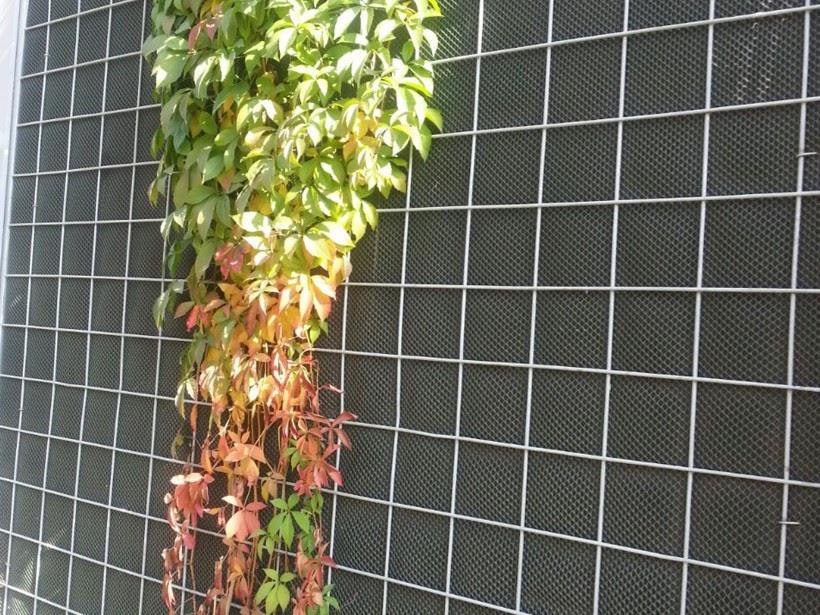
Bird Collision Screen
Bird Collision Screens are designed to prevent birds from colliding with vehicles or trains traveling on the tracks. Thanks to this type of screen, we can prevent flight areas and migratory flows from being interfered with by road or rail traffic.

Screen for wildlife passage
Screens for wildlife passage are installed in the overpasses conditioned to protect the passage of fauna and livestock that circulate along the tracks. These are wooden panels that are supplied provided with a chemical treatment that guarantees the preventive and curative action of insects and fungi as well as solar radiation. Further. The wood panels favor the respect for the environment.
As you can see, at Metalesa we work to promote a commitment to sustainability and the protection of the environment from all the areas in which we can cover. From internal initiatives such as the reduction of emissions and discharges, or the creation of training and development programs to improve the way we live, to the reduction of the environmental impact of the manufacture of our products.
One of the main pillars within Metalesa’s vision is the improvement of society and this happens through, among other things, reducing the impact generated on the environment. In addition to continuing to enhance everything that we have explained in this post, we will continue working to increase our effect on the preservation of the environment and the improvement of people’s quality of life.
